I'm still slowly ticking off jobs on the whiteboard, and although this wasn't a "pre-wof" job, I wanted to get it done before a couple of other jobs in the queue that were.
Back in Feb I reinstalled the refurbished and tested heater box, but I never actually connected the heater core to anything, presuming that I would do it later. I'll tell you now, I wish I had at least fit a pair of 90 degree hoses off the heater core when it was out and easy to access, instead of doing it in the car.
The plan here to was get the heater connected and working, before installing the carpet into the car, just in case it did decide to spring a leak, it won't damage the carpet.
A while ago I ordered 1 meter of 51mm flexible ducting from Aliexpress to run from the outlets on the bottom of the heater box and up to the windscreen vents, this will allow me to direct air to the windscreen to demist it. This fits inside the plastic 90 degree joints on the bottom of the heater box, and on the outside of the dash vents, as per factory.
I installed the vents into the dash first. These were a real pain in the backside to get into place, and work out which one went on which side.
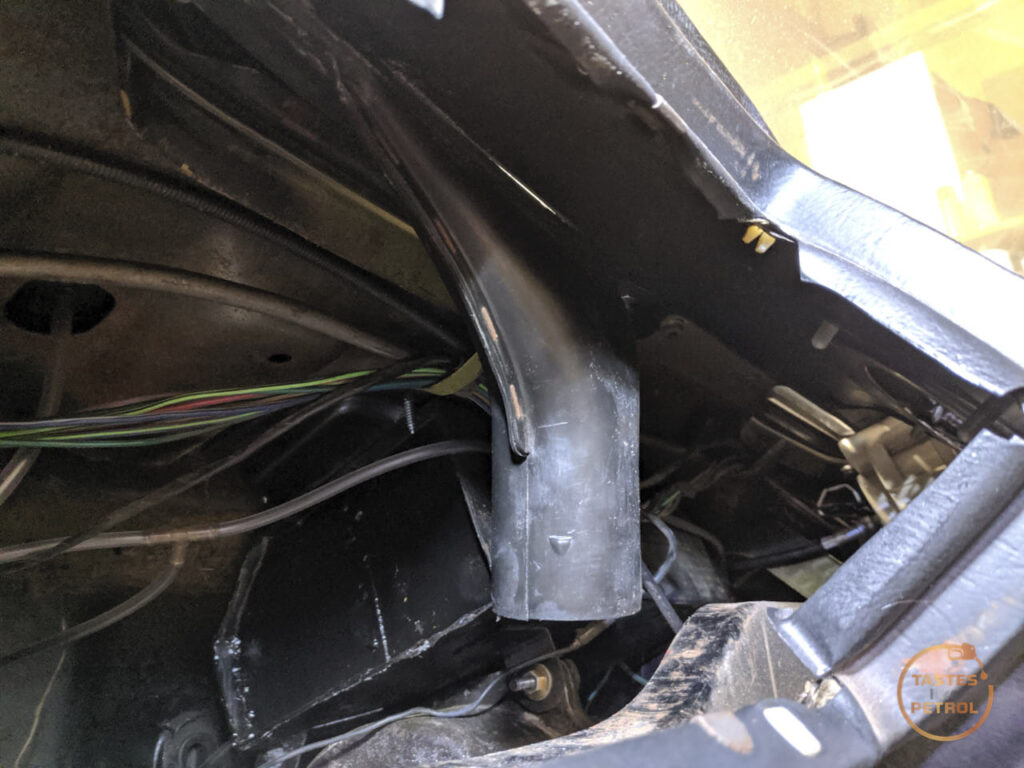
I got there in the end, and then cut some ducting and slipped it into place, using duct tape to seal and secure it.
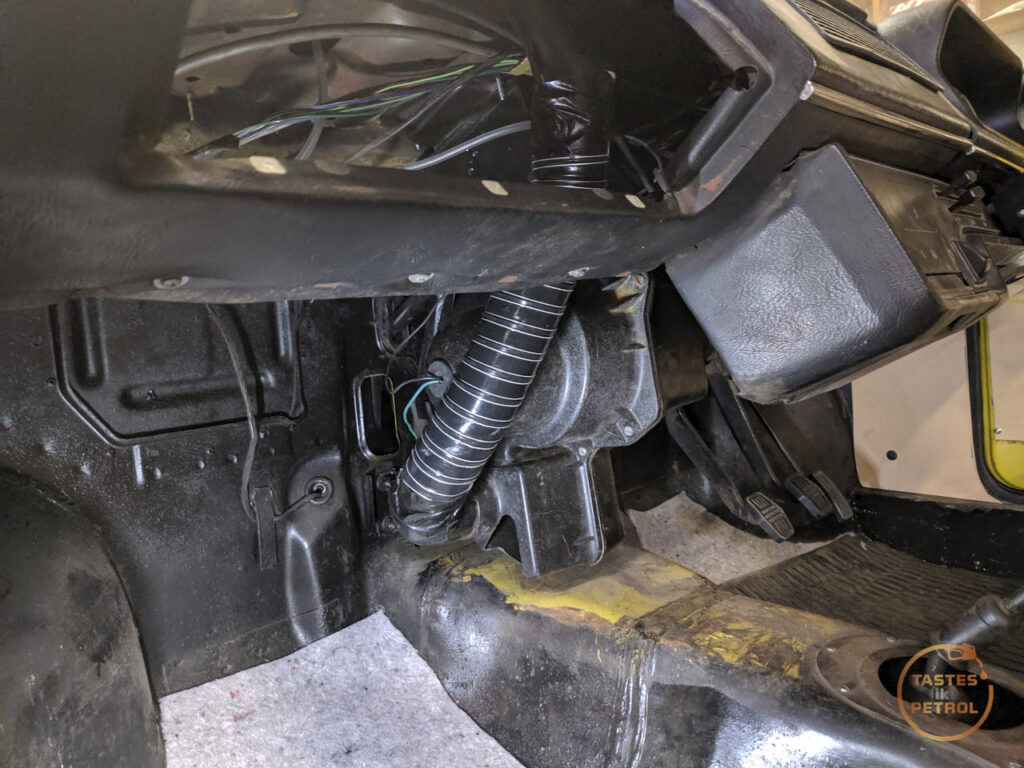

The driver's side is a bit less fun as there is less space to work and more wires in the way
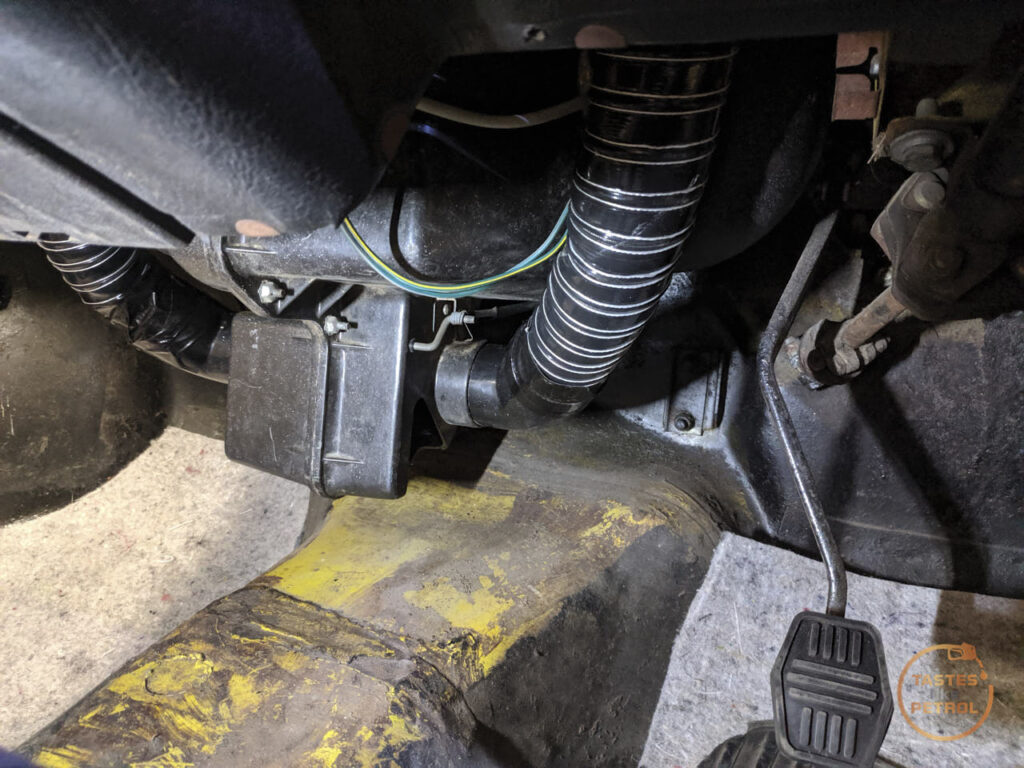
Unfortunately, after all the faffing about getting the dash vent in place, for whatever reason, it turns out the vent doesn't clear the speedo on the three-dial cluster and no amount of forcing it was going to allow them to share the limited space available.
I don't know if this is because the car originally had two dials and the vent is different, or if I was doing something wrong, but in the end, I removed the dash vent, and zip-tied the duct to the dash structure. This still blows out through the slot in the dash, it's just not as directed as it should be. It's better than nothing.
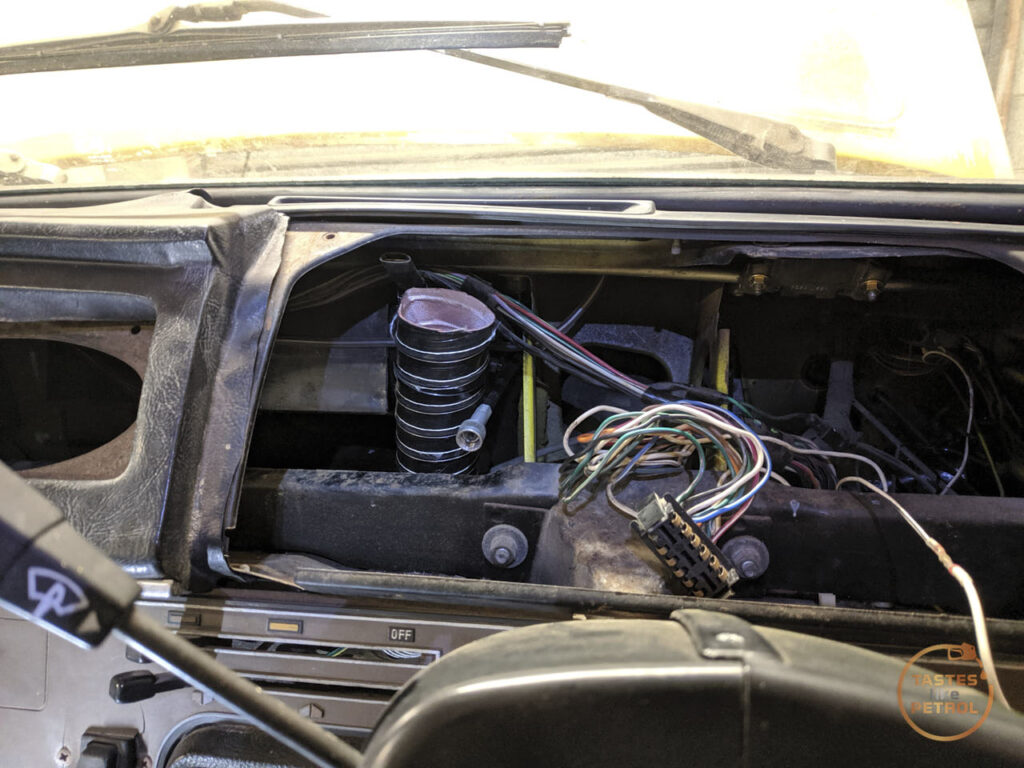
Speaking of the dash cluster, once I refitted it, and the steering wheel (since I removed it to give me more space to work under the dash), I refitted the steering wheel center pad for the first time since I got the car. This wheel is only until the car is on the road and then I have a nice aftermarket one to fit, but it's a milestone nonetheless.

Who doesn't love a good plughole of despair?
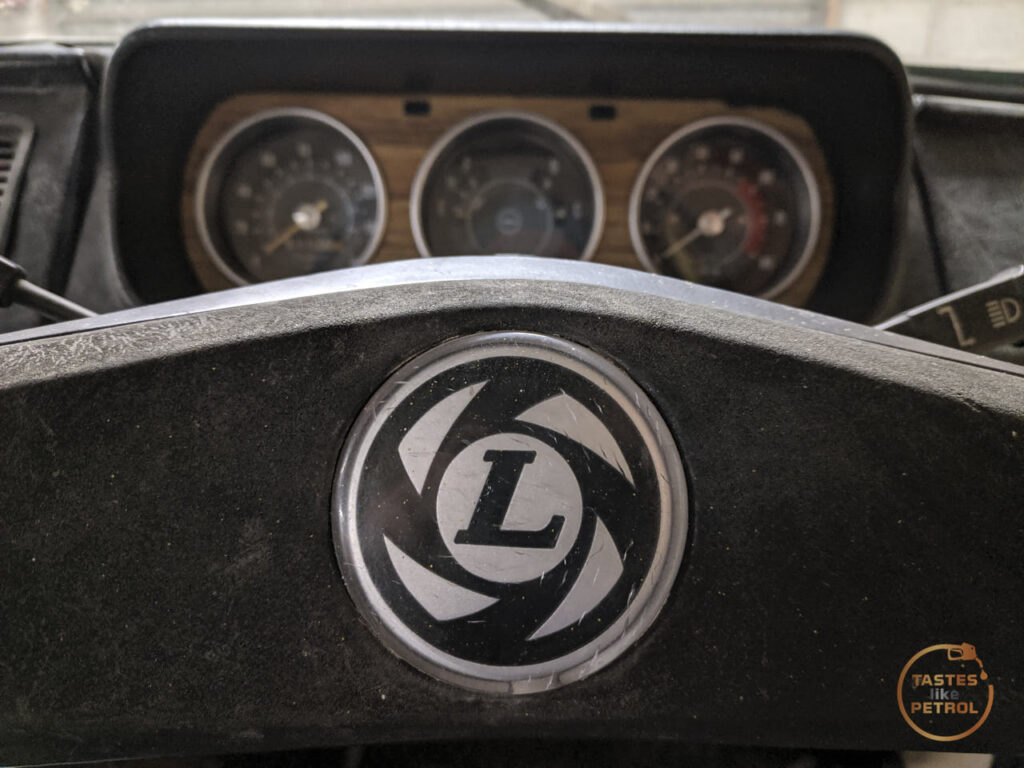
Testing the vents with the functional two-speed blower showed ample air being blown in the general direction of the windscreen.
The next step was to actually hook up the heater core to the cooling circuit.
This required me to obtain a couple (2-3) meters of 1/2" heater hose, and a pair of "Z" hoses (universal hoses that have a 90 and a 45 degree bend with a couple of straights, for cutting to fit). I also obtained a brass joiner, and brass "ball" valve.
The Z hoses are to give me a pair of 90 degree fittings out of the heater core. I'm not running the standard heater valve that mounts to the box and is controlled with the cable, as I don't have a good one, and replacements are expensive. I don't care much for needing to change the temp often, so I chose to regulate the temperature with a ball valve in the hose instead. Winter mode, and summer mode.
Because I'm not running the standard heater valve, I needed the hoses to clear the brackets immediately in front of the heater core outlets and then exit through the hole in the firewall. A normal hose would kink when trying to bend that sharp, so it had to be a 90 degree moulded bend.
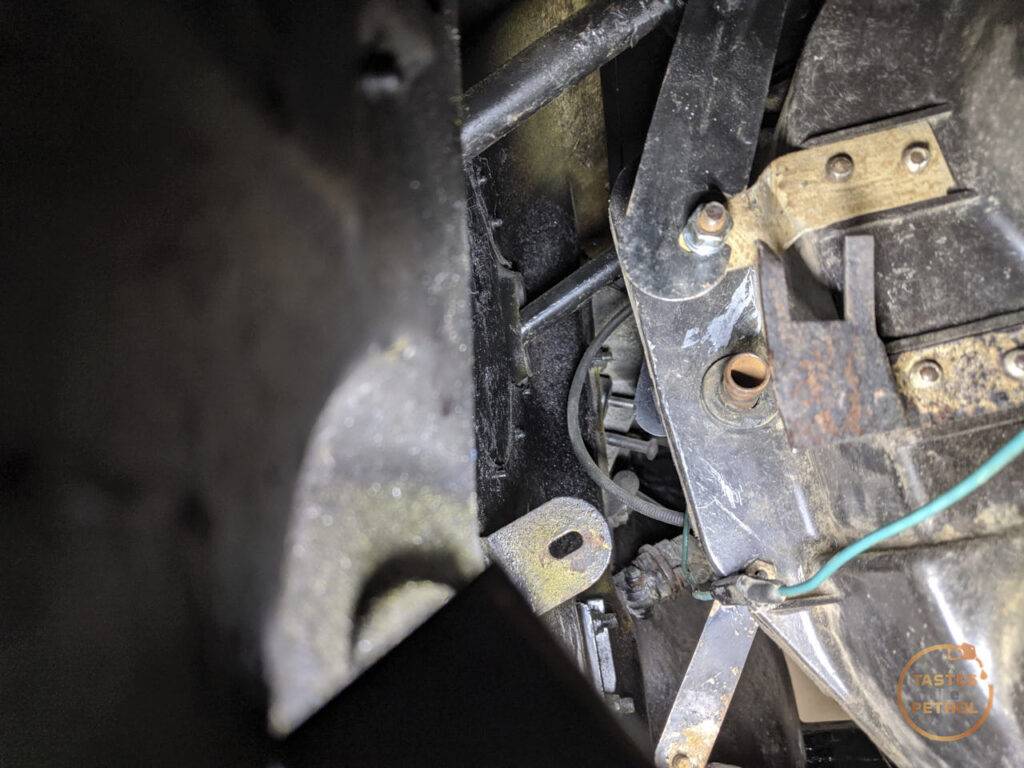 The upper heater core pipe is above the one visible, completely blocked by the bracket
The upper heater core pipe is above the one visible, completely blocked by the bracket
Z hoses are perfect for this sort of thing. I found these Aeroflow silicone ones locally at a reasonable price
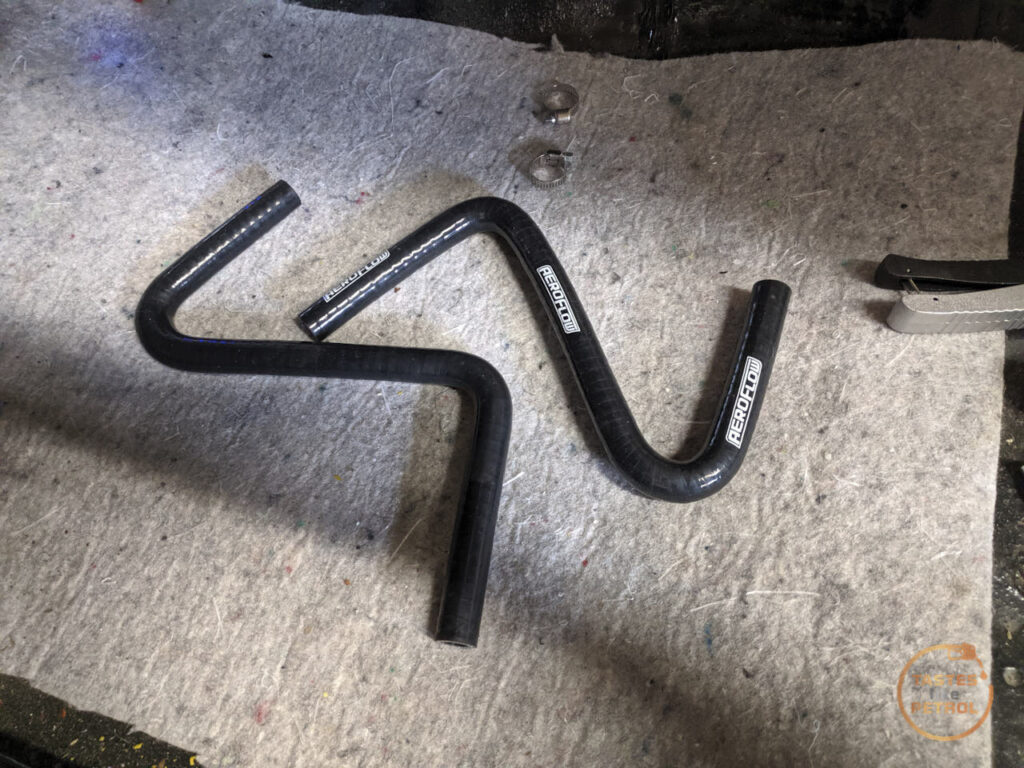
I cut the 45 off and shortened the 90 so it would fit
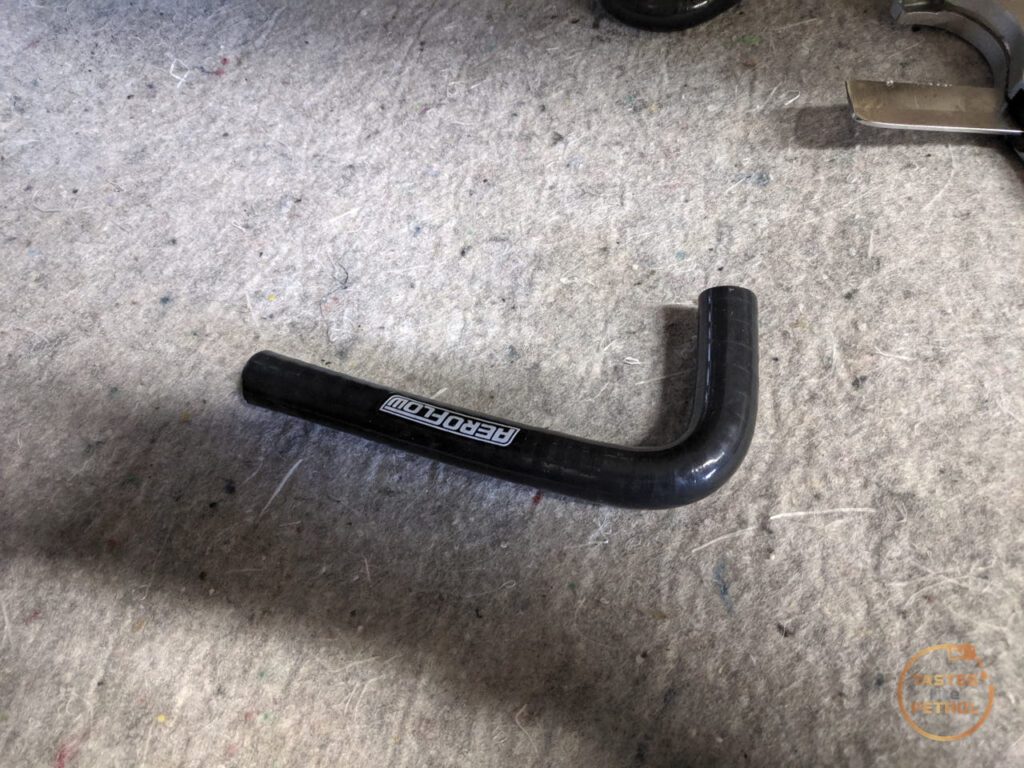
I then proceeded to fight with the hose for the next half hour or so, trying to get it fully onto the upper pipe. The space is limited, and the visibility is zero, so it was all done by feel, and I sure felt the sharp bits digging into me. I was very close to just giving up on fitting the heater, it was fighting me that hard, but eventually, with both hands up under the dash, my head on the trans tunnel and my legs hanging out of the car, it finally slipped into place.
The next fight was the hose clamp, getting that into place and tightening it, but we won't go into that.
The lower hose was much easier to fit, it more or less pressed into place and the clamp went on without much fuss.
Now that I had both stubs of hose poking through the firewall, I sprayed some silicone spray on the rubber grommet and pressed it onto the hoses and into the firewall.
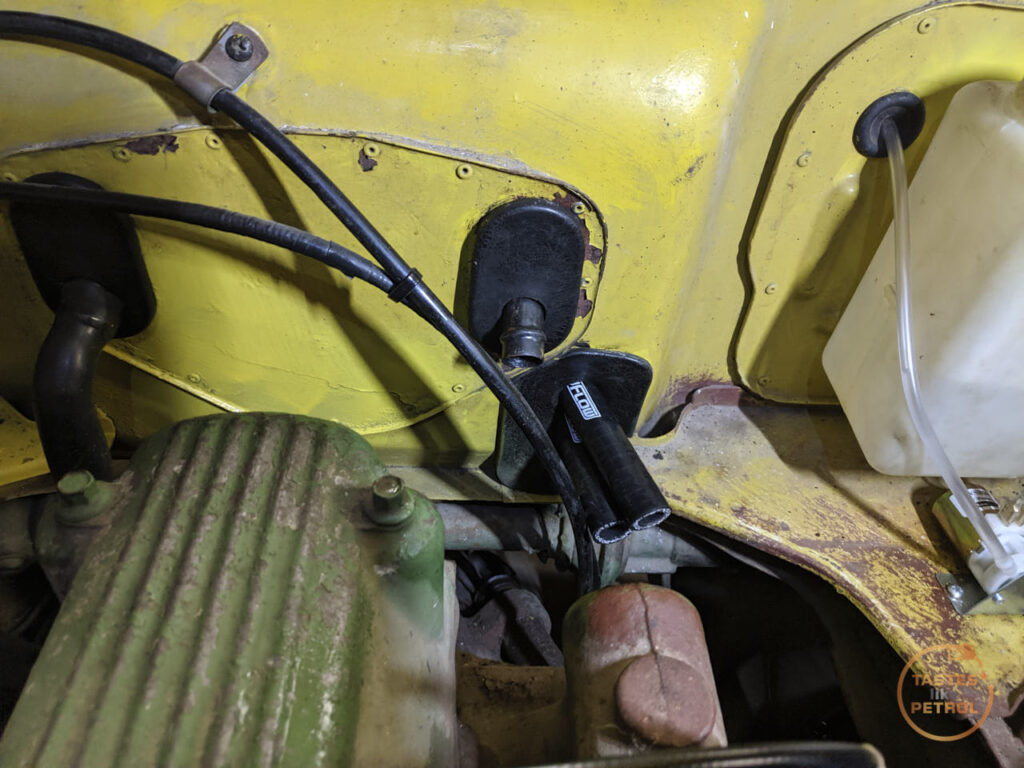
I had previously looped the heater hoses at the engine, as the previous owners had too (albeit their loop was a lot longer and had a joiner in the middle of it)

A bit of research showed that the top heater hose was the one that went to the standard heater valve, so that's the one I fit the tap into
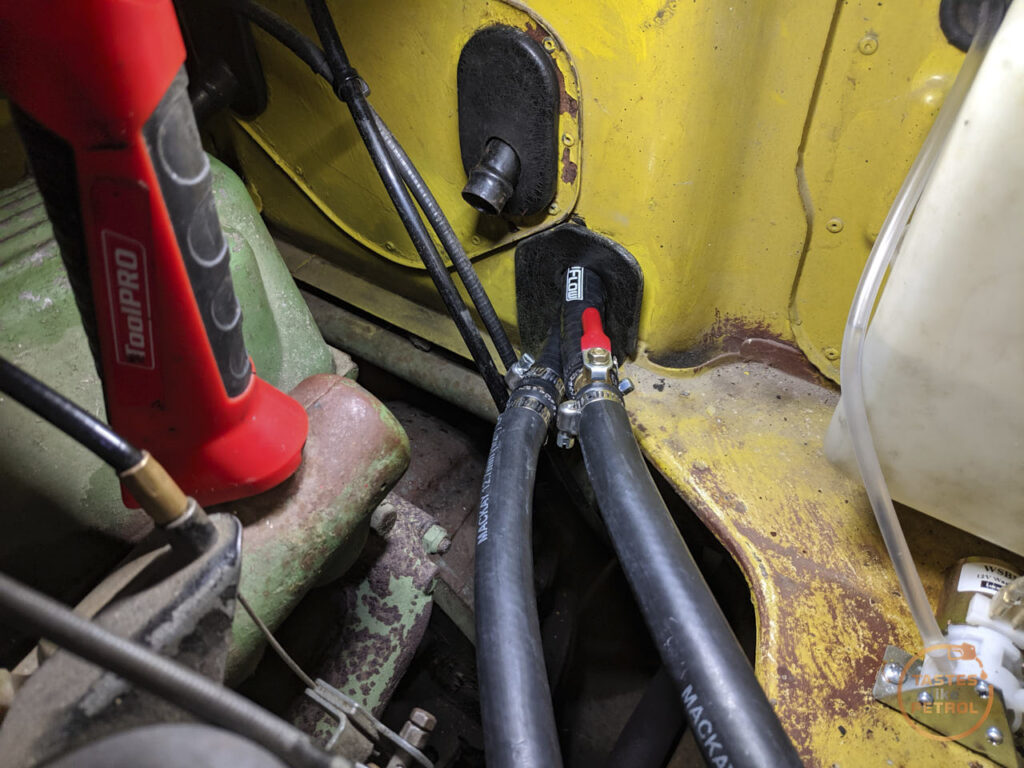
I had also seen in photos that the hoses are usually secured to the inner wing by a pair of P clamps. I located a hole that would've been where a self-tapper went into
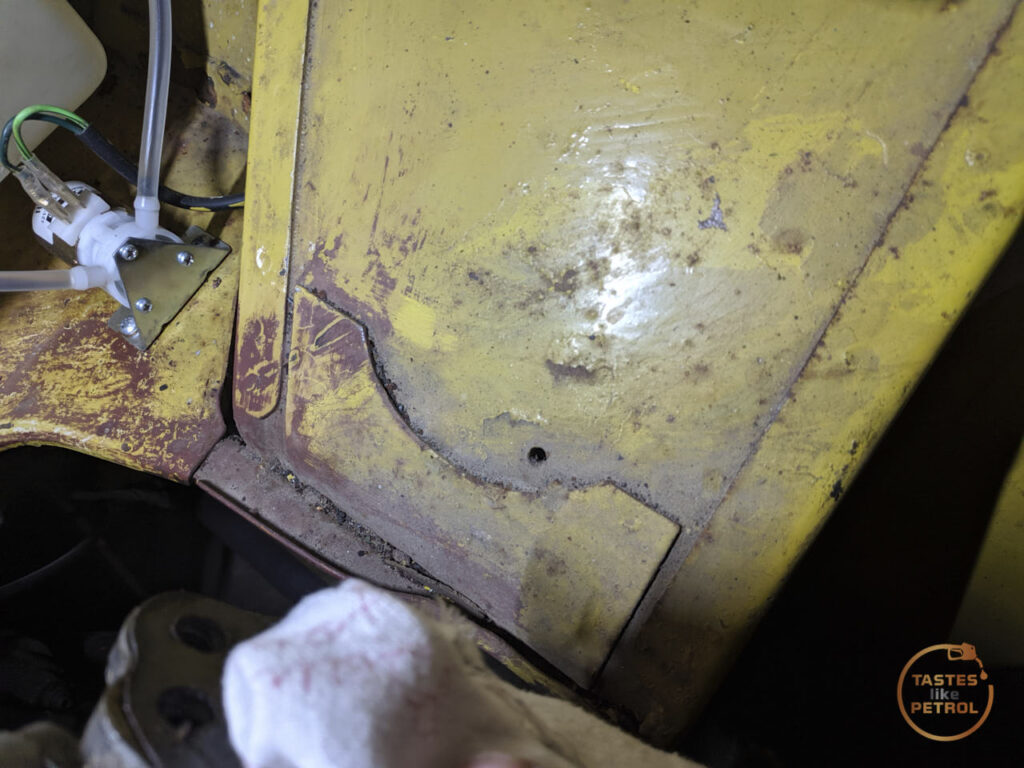
I hate using coarse threaded screws to secure things, so drilled it out a bit further

After coating it with some Rover Zircon Blue paint, I whacked an M5 Rivnut into it
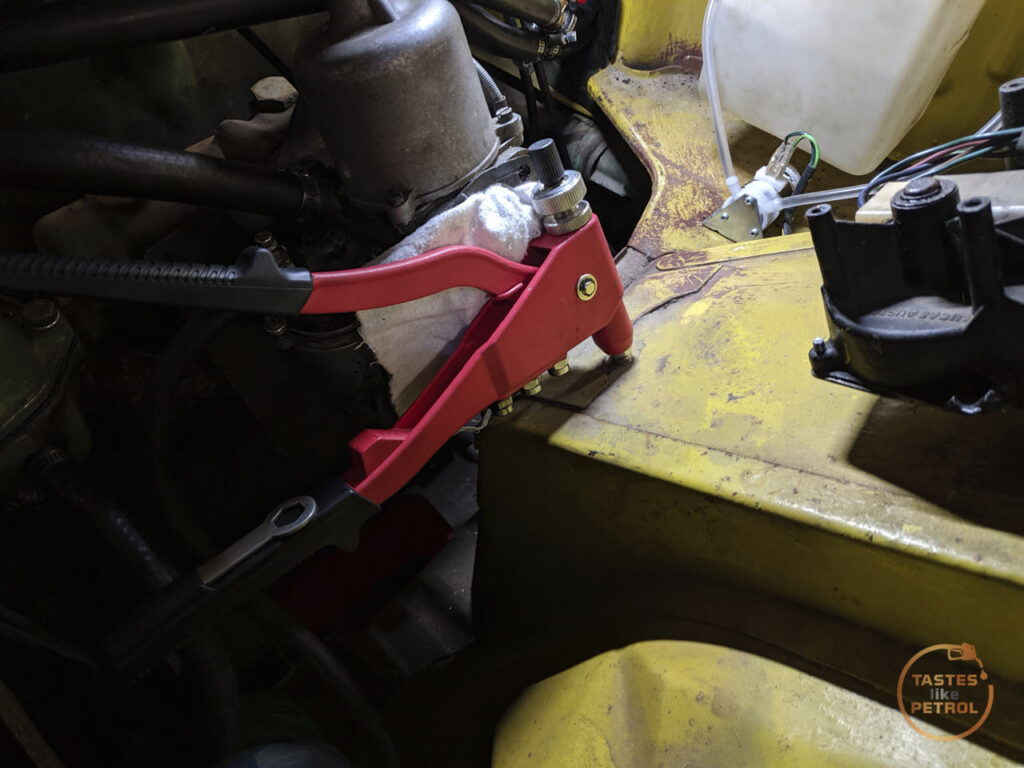

This allowed me to use a pair of P clamps to secure the hoses in place, keeping them tucked up nicely
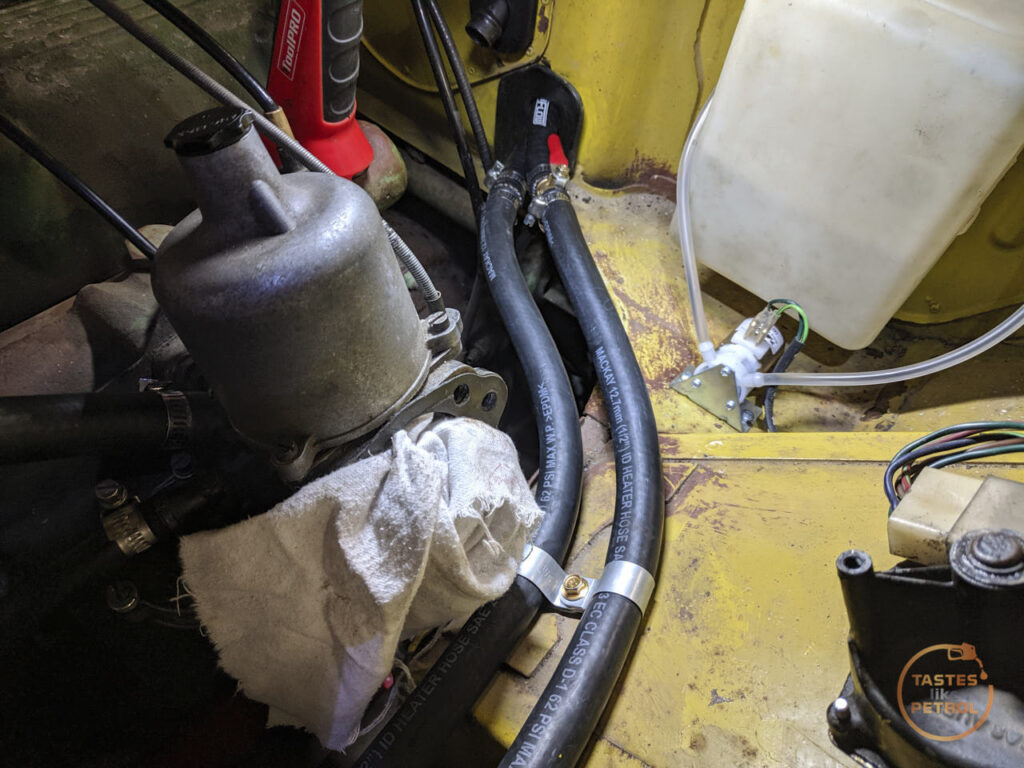
I then quickly juggled the old loop hose, spilled some coolant, and connected the two heater hoses
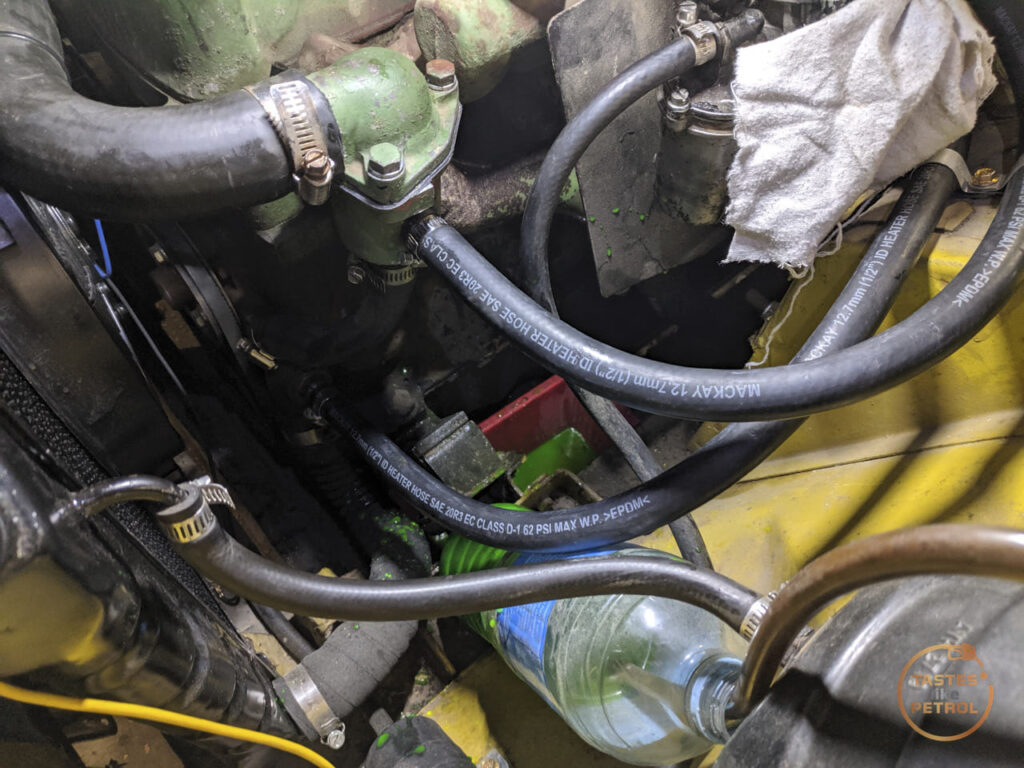
It's quite a nice tidy setup, and I'm quite proud of how well it has worked out. When the red lever on the valve is in line with the hose, the coolant is flowing in that direction, turn it 90 degrees and it's closed.

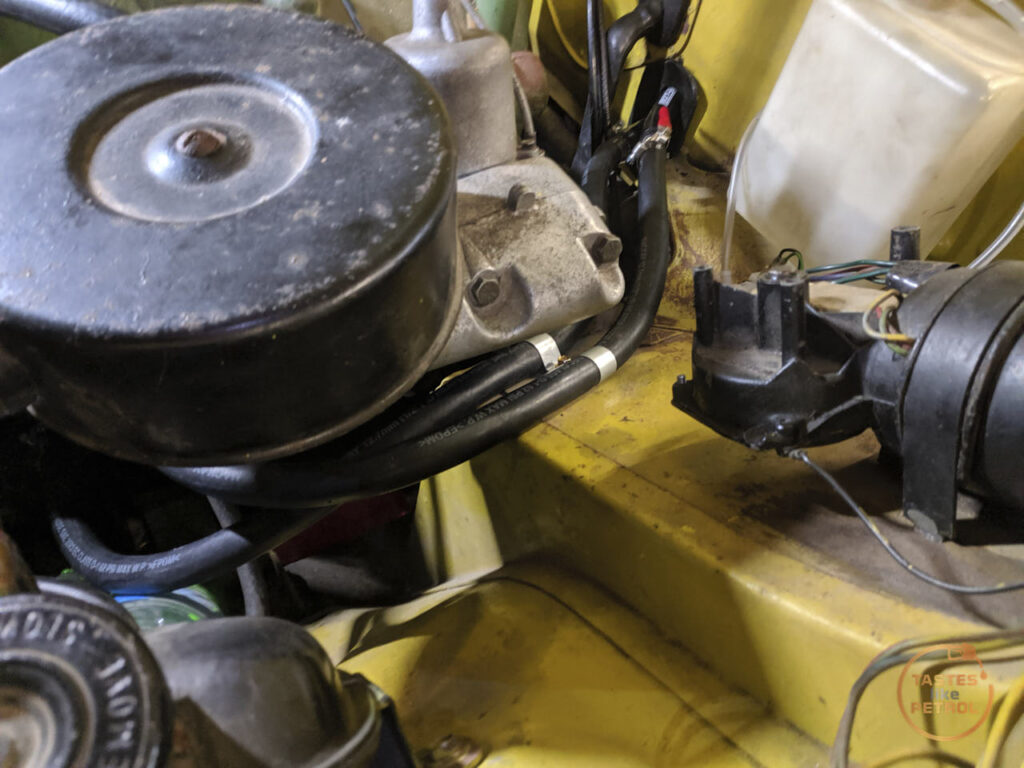
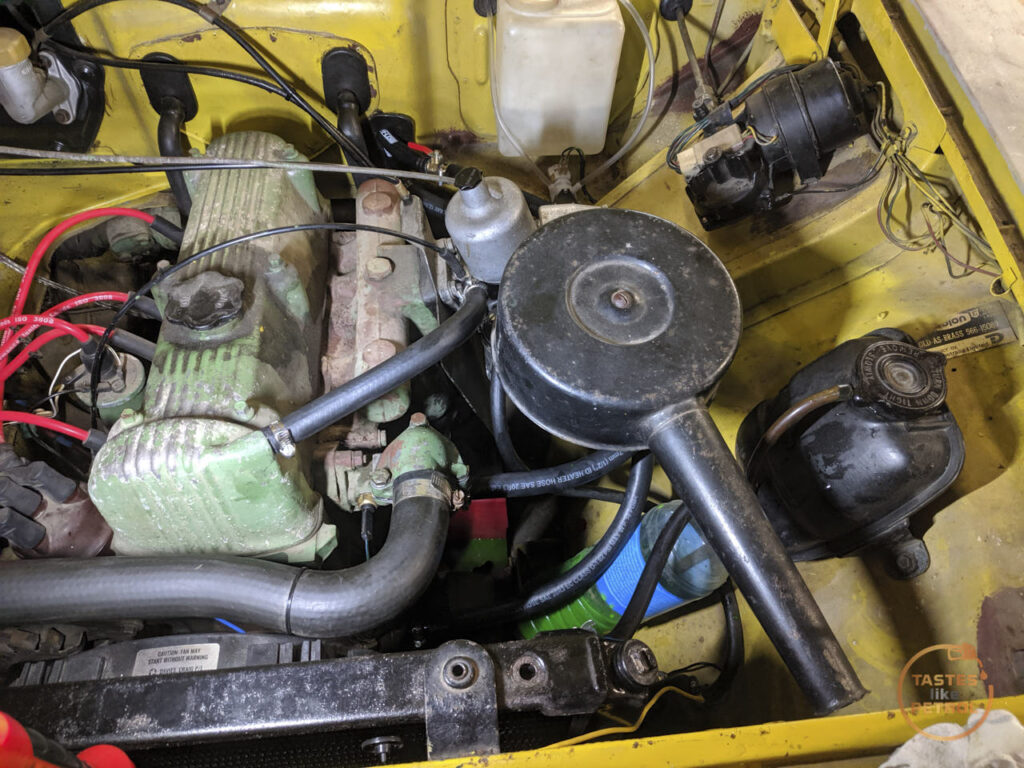
While I was there, spilling coolant on the floor, I also removed and swapped the coolant temp sender. I had never seen the coolant temp gauge rise, even when the coolant was warm enough to cycle the fan, so I wanted to see if replacing the sender helped.
I believe the old one was original and is marked Smiths. The terminal was wiggly, which I'm not sure if it's meant to be
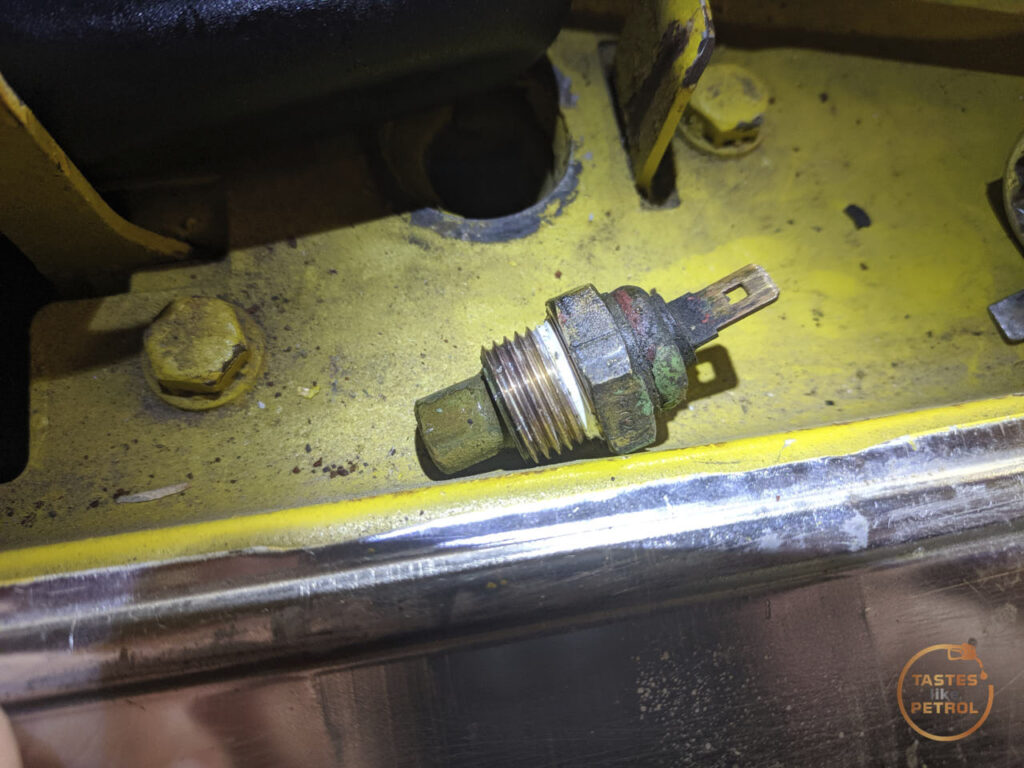
The replacement went straight in without issue.

Before firing the car up to take it outside and bleed the cooling system, I quickly filled the hole in the floor for the shifter.
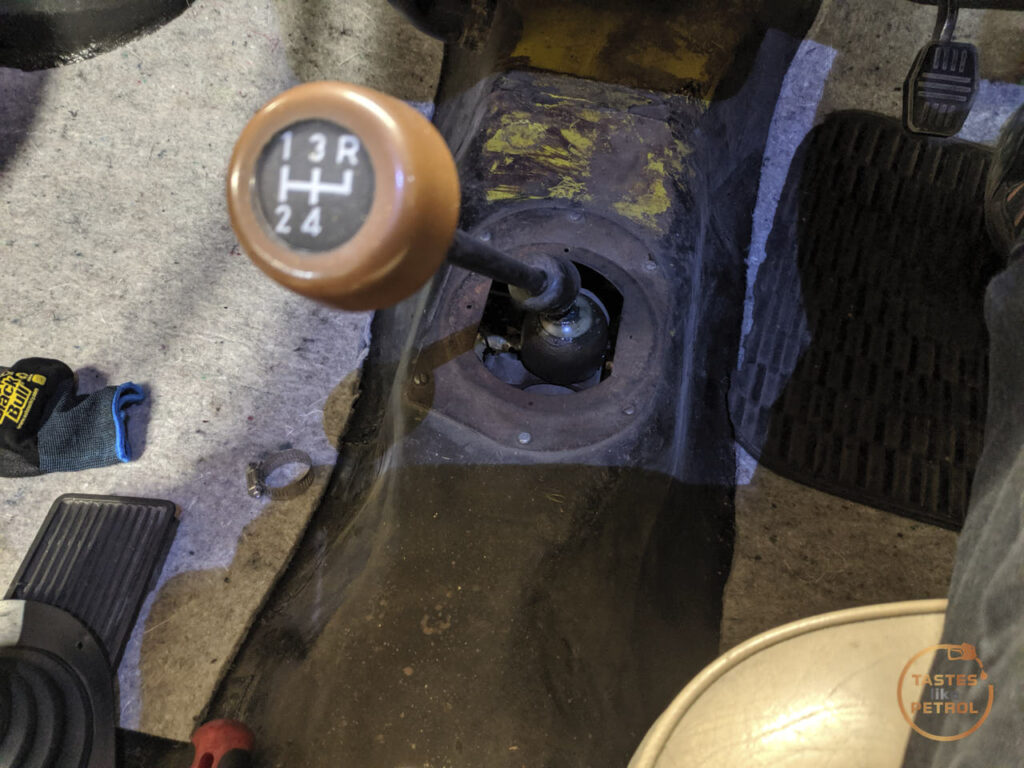
Originally this would've had a lump of foam around the shifter shaft and covered by a nice "leather" shift boot with a metal ring
![]() tasteslikepetrol.net/wp-content/uploads/2024/07/Screenshot-2024-07-13-at-9.24.03 PM-967x1024.png[/IMG]
tasteslikepetrol.net/wp-content/uploads/2024/07/Screenshot-2024-07-13-at-9.24.03 PM-967x1024.png[/IMG]
I have all these parts, but the boot is so manky you wouldn't want to touch it, let alone install it in the car. I plan to remake the shifter and handbrake boots in the same tan vinyl as the door cards, but in the meantime I just wanted to block it off so the WOF man wouldn't be looking at the road during its test.
I bought a MK2 boot from a nice fellow Marina owner, and figured I could make it work. This is the less attractive once-piece rubber deal, which was also used on some UK MK1 cars
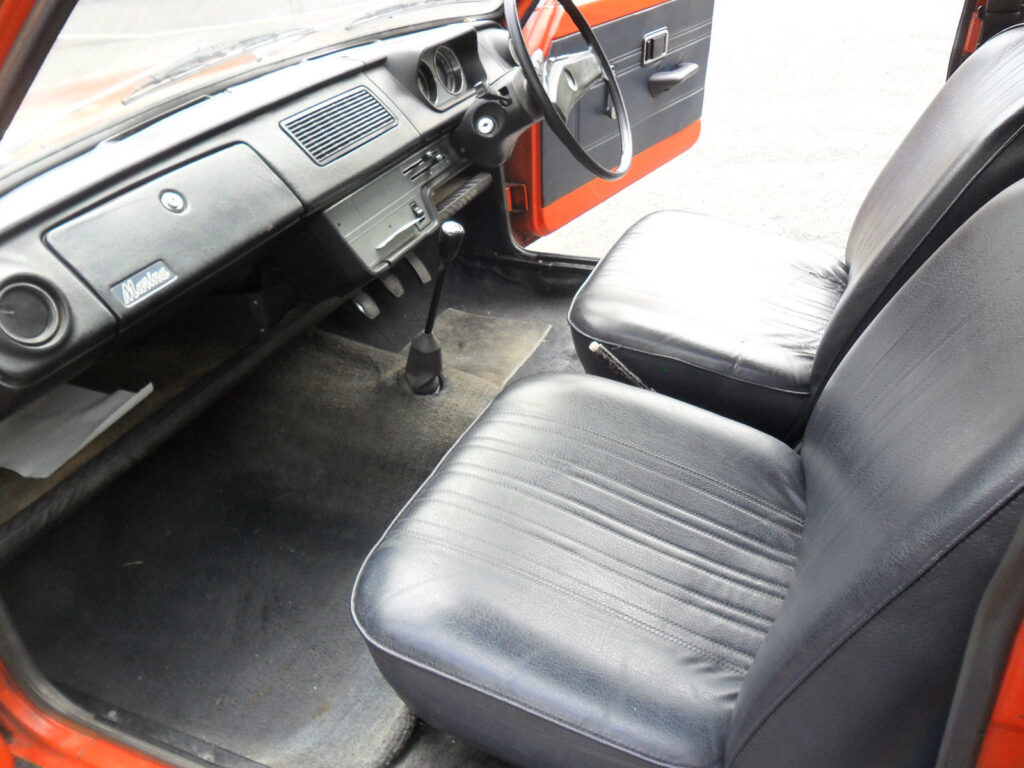
I removed the surround plate from the floor and inserted the rubber boot. It turned out that almost all the holes in the boot lined up with the surround, so it screwed in nice and easy
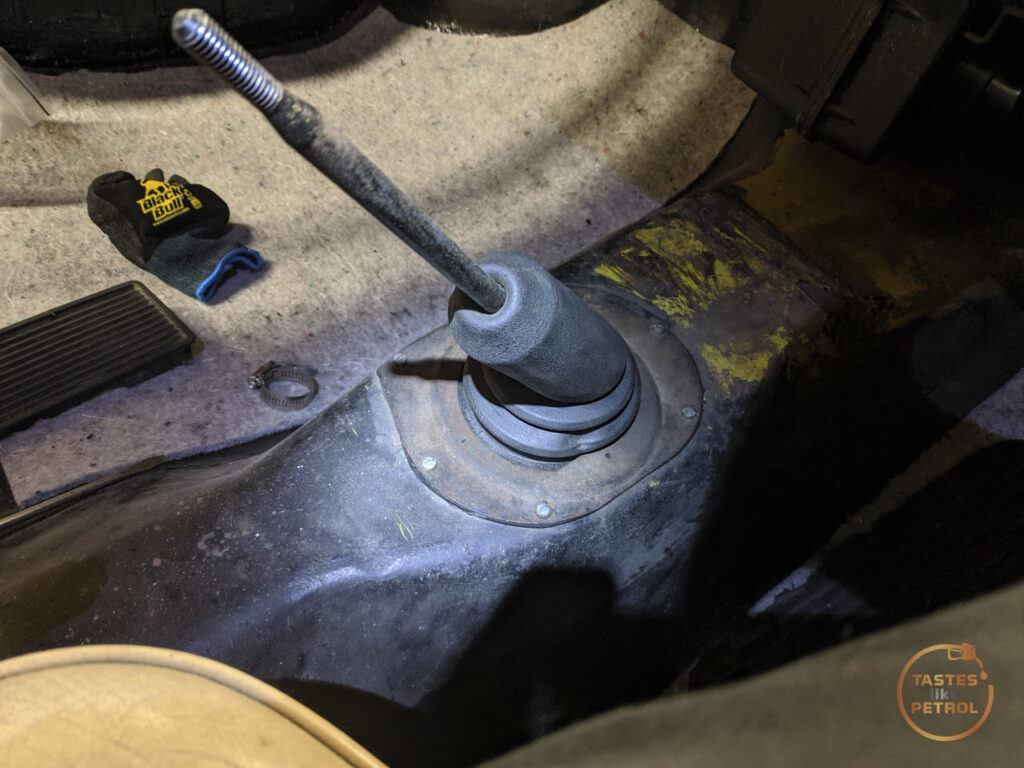
It's not perfect, I suspect cars that are meant to have this boot will have a larger opening in the surround plate, that locates in a ridge on the bottom of the boot, but mine has a smaller opening to support the metal ring of the standard boot. It still works though, and seals the cabin from the outside world.
And with that done, I topped the radiator and expansion tank up and started the car. It really needs some nice new fuel, the old stale fuel makes it really hard to start, but the replacement starter is bliss to use and the engine turns over quickly every time.
Eventually the engine fired up on all cylinders and settled into a nice fast idle. I jumped in, popped it into gear and headed for the garage exit. I didn't quite make it the first time before the cold engine bogged down, so I rolled back and gave it another go, with more revs, and a bit of a run-up to get up my steep driveway. Apparently, this also meant that I did a nice unintentional single-wheel burnout in the garage Just can't harness all that OHC power!
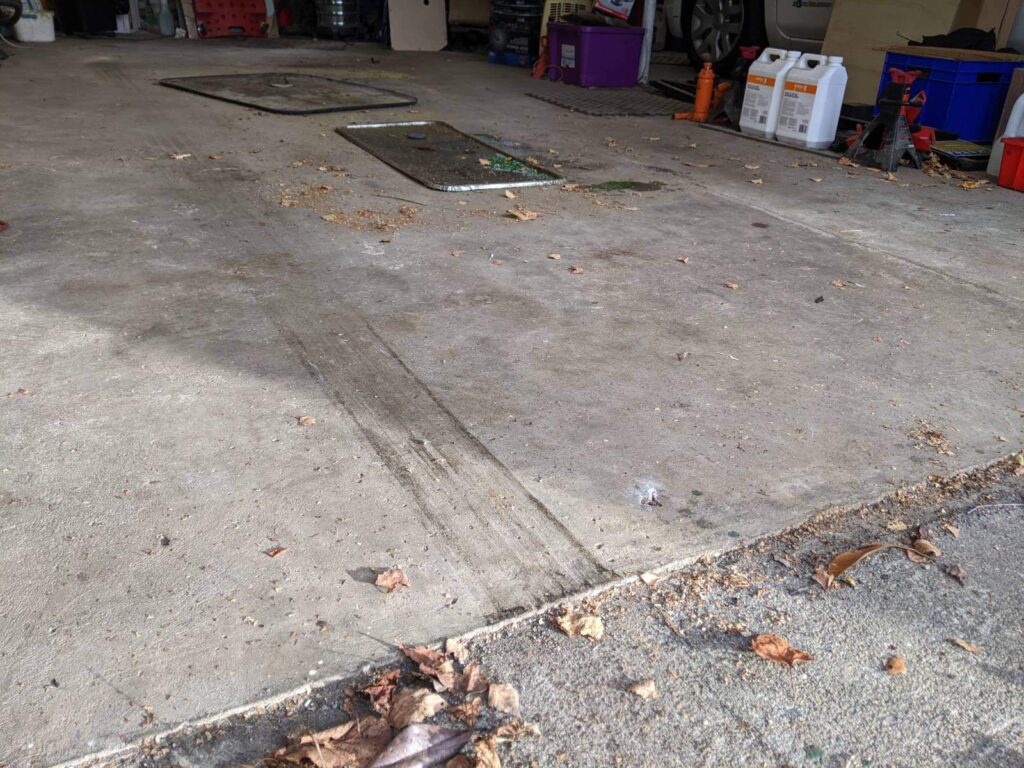
But make it we did. Once outside I got the hose out and gave the engine bay a quick hose down to wash out all the coolant I had spilled (and all the dirt and muck from years of sitting).
This little burst of "cleaning" ended up in the Marina finally seeing the first "wash" of my ownership. Yes, it was only a hose down, but already it's a lot cleaner. It's crazy how much dirt was washed away, after 20+ years of sitting and 3 years of me cutting, grinding, and sanding.
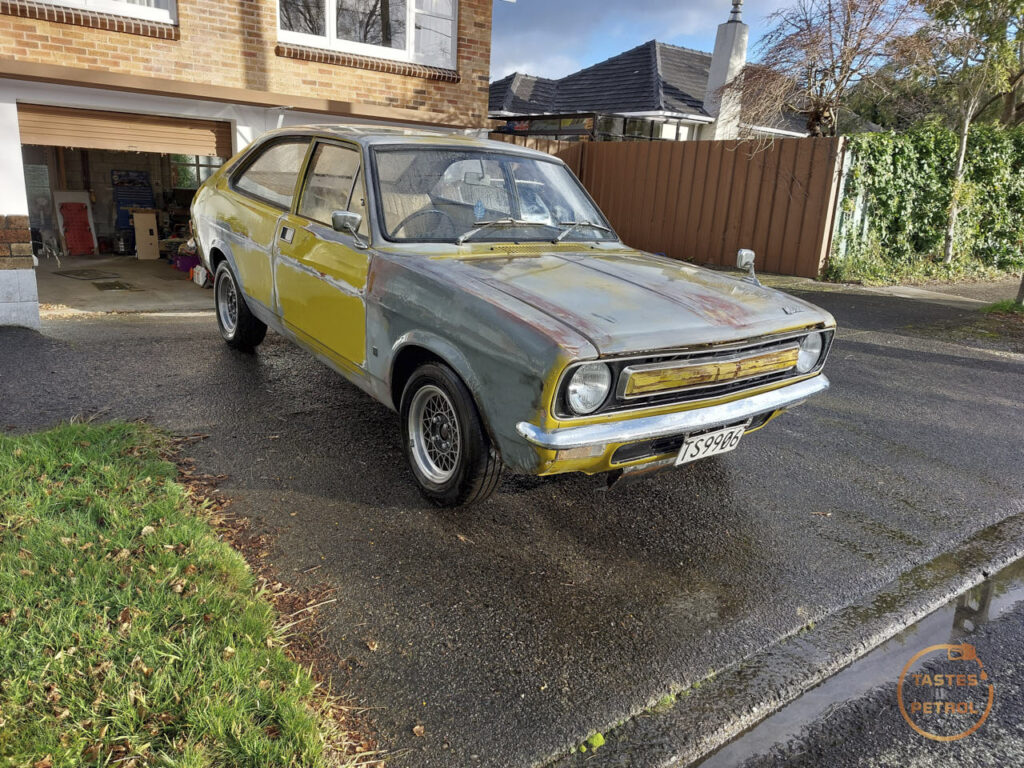
It's no show car, or even clean, by any stretch of the imagination, but at least I can touch the panels without getting filthy now.
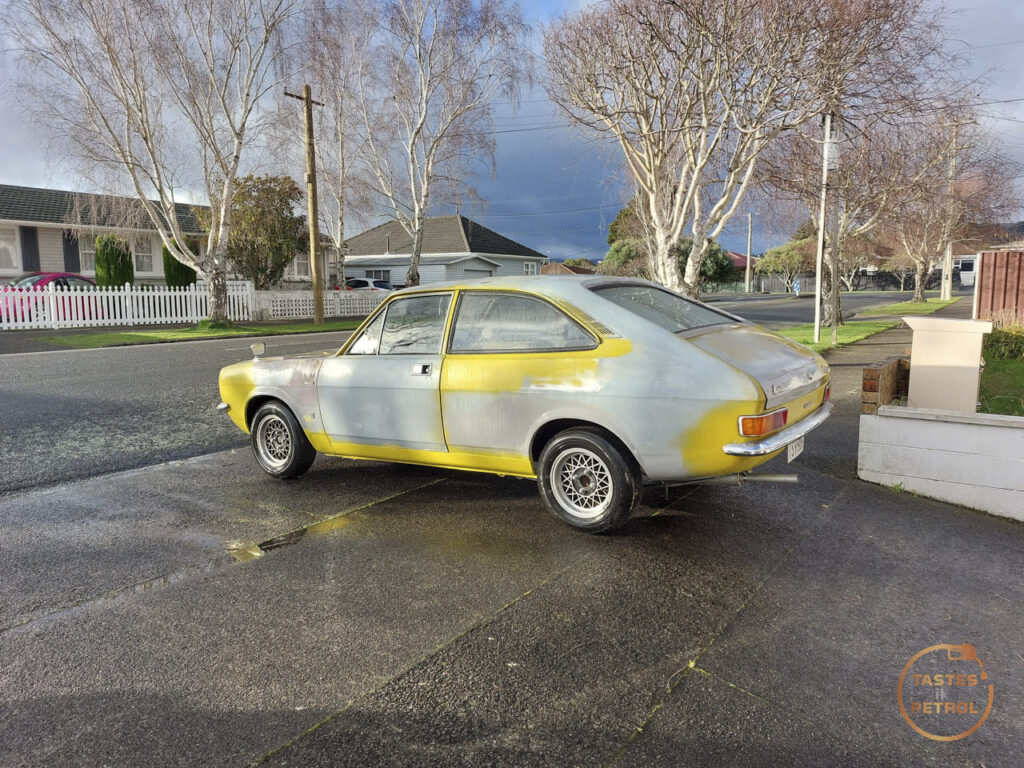
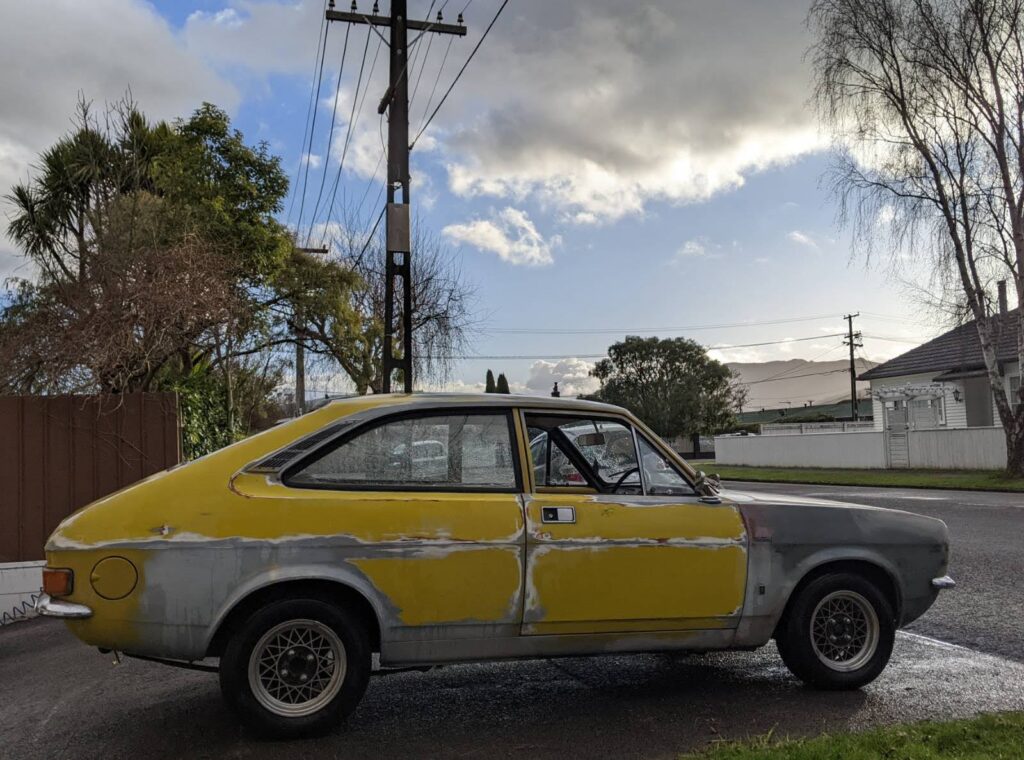
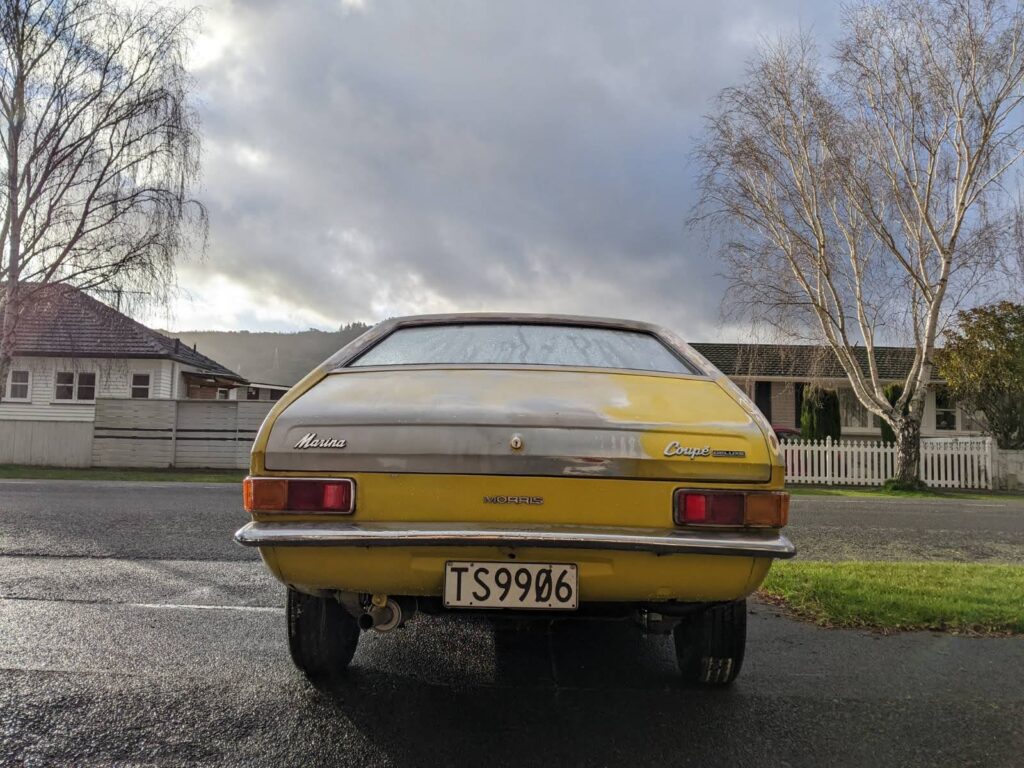

Even with me blasting the car with the hose, the interior was reasonably leak-free, except where expected. The front windscreen leaks like a sieve (expected, the seal is wrong and doesn't fit), the rear windscreen has a tiny leak in the bottom corner, and the front quarterlight windows leaked a little too. Once the windscreen seal is replaced, the others should be fine to handle a little rain if I happen to get caught out.
The whole time it was outside the engine was just happily ticking over at idle, with the fan cutting in and out as needed. On a huge plus, the temp gauge now works.
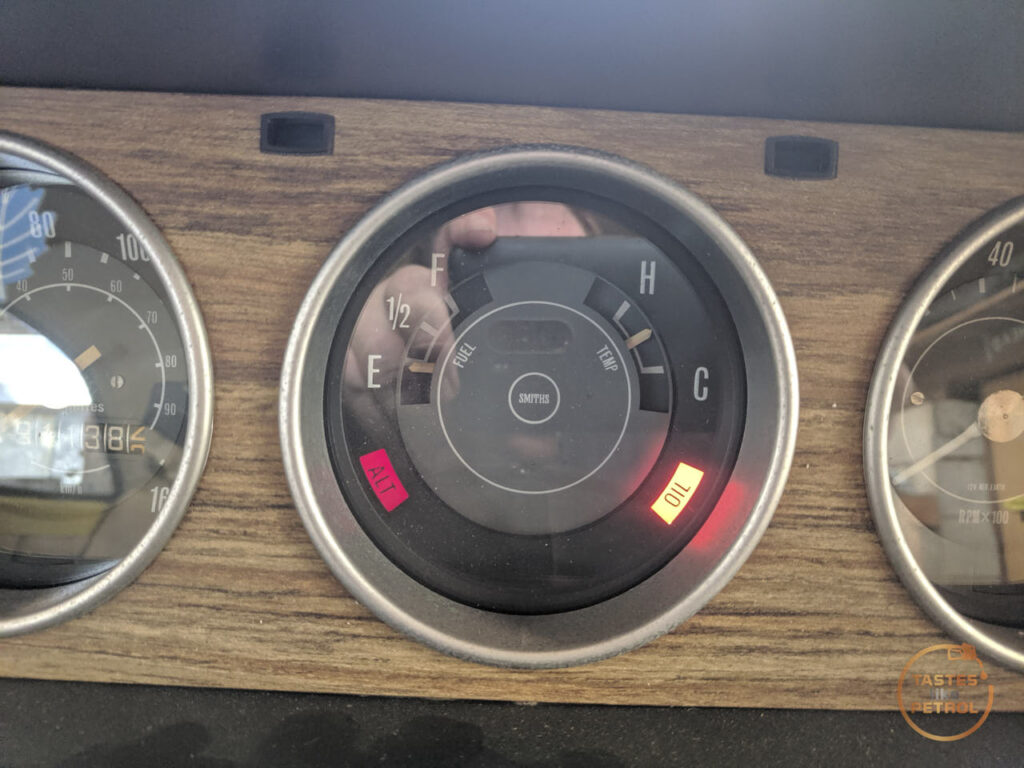
So what of the heater? well, I can confirm it blows nice warm air around the car, and if you leave it idling with the heater on, the blower on fast, and with the windows up, it becomes uncomfortably warm inside the car. Great success.
As far as I can see, there are no coolant leaks and everything is doing as it should.
Next, sound deadening and then carpet.
Back in Feb I reinstalled the refurbished and tested heater box, but I never actually connected the heater core to anything, presuming that I would do it later. I'll tell you now, I wish I had at least fit a pair of 90 degree hoses off the heater core when it was out and easy to access, instead of doing it in the car.
The plan here to was get the heater connected and working, before installing the carpet into the car, just in case it did decide to spring a leak, it won't damage the carpet.
A while ago I ordered 1 meter of 51mm flexible ducting from Aliexpress to run from the outlets on the bottom of the heater box and up to the windscreen vents, this will allow me to direct air to the windscreen to demist it. This fits inside the plastic 90 degree joints on the bottom of the heater box, and on the outside of the dash vents, as per factory.
I installed the vents into the dash first. These were a real pain in the backside to get into place, and work out which one went on which side.

I got there in the end, and then cut some ducting and slipped it into place, using duct tape to seal and secure it.


The driver's side is a bit less fun as there is less space to work and more wires in the way

Unfortunately, after all the faffing about getting the dash vent in place, for whatever reason, it turns out the vent doesn't clear the speedo on the three-dial cluster and no amount of forcing it was going to allow them to share the limited space available.
I don't know if this is because the car originally had two dials and the vent is different, or if I was doing something wrong, but in the end, I removed the dash vent, and zip-tied the duct to the dash structure. This still blows out through the slot in the dash, it's just not as directed as it should be. It's better than nothing.

Speaking of the dash cluster, once I refitted it, and the steering wheel (since I removed it to give me more space to work under the dash), I refitted the steering wheel center pad for the first time since I got the car. This wheel is only until the car is on the road and then I have a nice aftermarket one to fit, but it's a milestone nonetheless.

Who doesn't love a good plughole of despair?

Testing the vents with the functional two-speed blower showed ample air being blown in the general direction of the windscreen.
The next step was to actually hook up the heater core to the cooling circuit.
This required me to obtain a couple (2-3) meters of 1/2" heater hose, and a pair of "Z" hoses (universal hoses that have a 90 and a 45 degree bend with a couple of straights, for cutting to fit). I also obtained a brass joiner, and brass "ball" valve.
The Z hoses are to give me a pair of 90 degree fittings out of the heater core. I'm not running the standard heater valve that mounts to the box and is controlled with the cable, as I don't have a good one, and replacements are expensive. I don't care much for needing to change the temp often, so I chose to regulate the temperature with a ball valve in the hose instead. Winter mode, and summer mode.
Because I'm not running the standard heater valve, I needed the hoses to clear the brackets immediately in front of the heater core outlets and then exit through the hole in the firewall. A normal hose would kink when trying to bend that sharp, so it had to be a 90 degree moulded bend.
 The upper heater core pipe is above the one visible, completely blocked by the bracket
The upper heater core pipe is above the one visible, completely blocked by the bracketZ hoses are perfect for this sort of thing. I found these Aeroflow silicone ones locally at a reasonable price

I cut the 45 off and shortened the 90 so it would fit

I then proceeded to fight with the hose for the next half hour or so, trying to get it fully onto the upper pipe. The space is limited, and the visibility is zero, so it was all done by feel, and I sure felt the sharp bits digging into me. I was very close to just giving up on fitting the heater, it was fighting me that hard, but eventually, with both hands up under the dash, my head on the trans tunnel and my legs hanging out of the car, it finally slipped into place.
The next fight was the hose clamp, getting that into place and tightening it, but we won't go into that.
The lower hose was much easier to fit, it more or less pressed into place and the clamp went on without much fuss.
Now that I had both stubs of hose poking through the firewall, I sprayed some silicone spray on the rubber grommet and pressed it onto the hoses and into the firewall.

I had previously looped the heater hoses at the engine, as the previous owners had too (albeit their loop was a lot longer and had a joiner in the middle of it)

A bit of research showed that the top heater hose was the one that went to the standard heater valve, so that's the one I fit the tap into

I had also seen in photos that the hoses are usually secured to the inner wing by a pair of P clamps. I located a hole that would've been where a self-tapper went into

I hate using coarse threaded screws to secure things, so drilled it out a bit further

After coating it with some Rover Zircon Blue paint, I whacked an M5 Rivnut into it


This allowed me to use a pair of P clamps to secure the hoses in place, keeping them tucked up nicely

I then quickly juggled the old loop hose, spilled some coolant, and connected the two heater hoses

It's quite a nice tidy setup, and I'm quite proud of how well it has worked out. When the red lever on the valve is in line with the hose, the coolant is flowing in that direction, turn it 90 degrees and it's closed.



While I was there, spilling coolant on the floor, I also removed and swapped the coolant temp sender. I had never seen the coolant temp gauge rise, even when the coolant was warm enough to cycle the fan, so I wanted to see if replacing the sender helped.
I believe the old one was original and is marked Smiths. The terminal was wiggly, which I'm not sure if it's meant to be

The replacement went straight in without issue.

Before firing the car up to take it outside and bleed the cooling system, I quickly filled the hole in the floor for the shifter.

Originally this would've had a lump of foam around the shifter shaft and covered by a nice "leather" shift boot with a metal ring
I have all these parts, but the boot is so manky you wouldn't want to touch it, let alone install it in the car. I plan to remake the shifter and handbrake boots in the same tan vinyl as the door cards, but in the meantime I just wanted to block it off so the WOF man wouldn't be looking at the road during its test.
I bought a MK2 boot from a nice fellow Marina owner, and figured I could make it work. This is the less attractive once-piece rubber deal, which was also used on some UK MK1 cars

I removed the surround plate from the floor and inserted the rubber boot. It turned out that almost all the holes in the boot lined up with the surround, so it screwed in nice and easy

It's not perfect, I suspect cars that are meant to have this boot will have a larger opening in the surround plate, that locates in a ridge on the bottom of the boot, but mine has a smaller opening to support the metal ring of the standard boot. It still works though, and seals the cabin from the outside world.
And with that done, I topped the radiator and expansion tank up and started the car. It really needs some nice new fuel, the old stale fuel makes it really hard to start, but the replacement starter is bliss to use and the engine turns over quickly every time.
Eventually the engine fired up on all cylinders and settled into a nice fast idle. I jumped in, popped it into gear and headed for the garage exit. I didn't quite make it the first time before the cold engine bogged down, so I rolled back and gave it another go, with more revs, and a bit of a run-up to get up my steep driveway. Apparently, this also meant that I did a nice unintentional single-wheel burnout in the garage Just can't harness all that OHC power!

But make it we did. Once outside I got the hose out and gave the engine bay a quick hose down to wash out all the coolant I had spilled (and all the dirt and muck from years of sitting).
This little burst of "cleaning" ended up in the Marina finally seeing the first "wash" of my ownership. Yes, it was only a hose down, but already it's a lot cleaner. It's crazy how much dirt was washed away, after 20+ years of sitting and 3 years of me cutting, grinding, and sanding.

It's no show car, or even clean, by any stretch of the imagination, but at least I can touch the panels without getting filthy now.




Even with me blasting the car with the hose, the interior was reasonably leak-free, except where expected. The front windscreen leaks like a sieve (expected, the seal is wrong and doesn't fit), the rear windscreen has a tiny leak in the bottom corner, and the front quarterlight windows leaked a little too. Once the windscreen seal is replaced, the others should be fine to handle a little rain if I happen to get caught out.
The whole time it was outside the engine was just happily ticking over at idle, with the fan cutting in and out as needed. On a huge plus, the temp gauge now works.

So what of the heater? well, I can confirm it blows nice warm air around the car, and if you leave it idling with the heater on, the blower on fast, and with the windows up, it becomes uncomfortably warm inside the car. Great success.
As far as I can see, there are no coolant leaks and everything is doing as it should.
Next, sound deadening and then carpet.












































































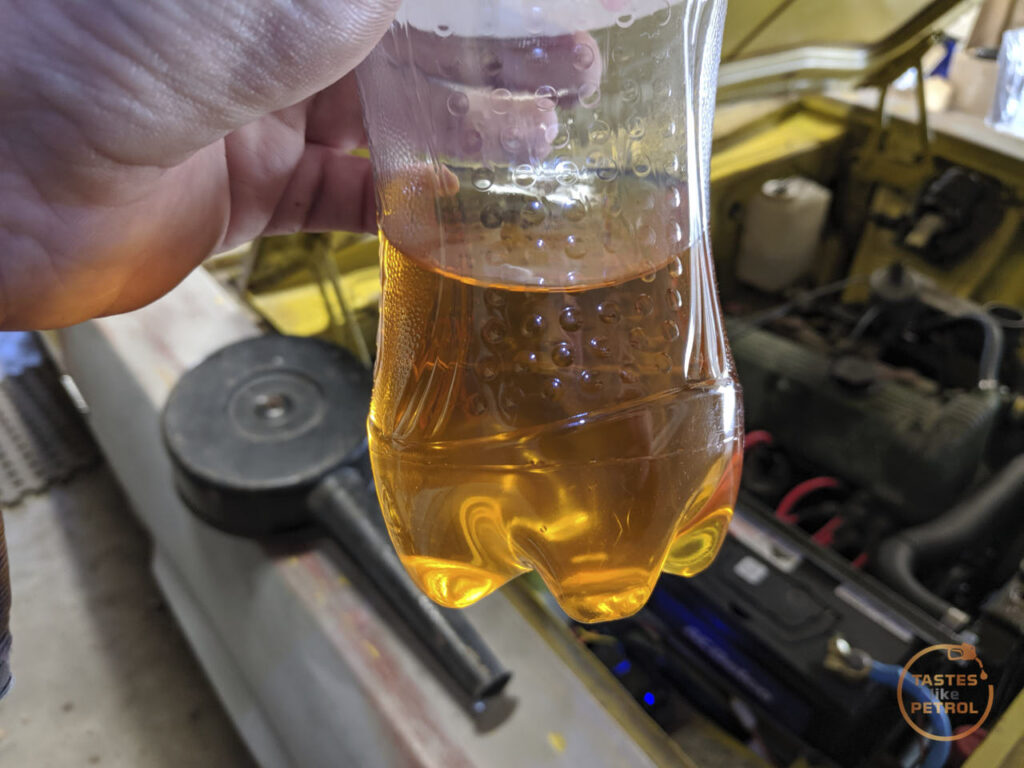
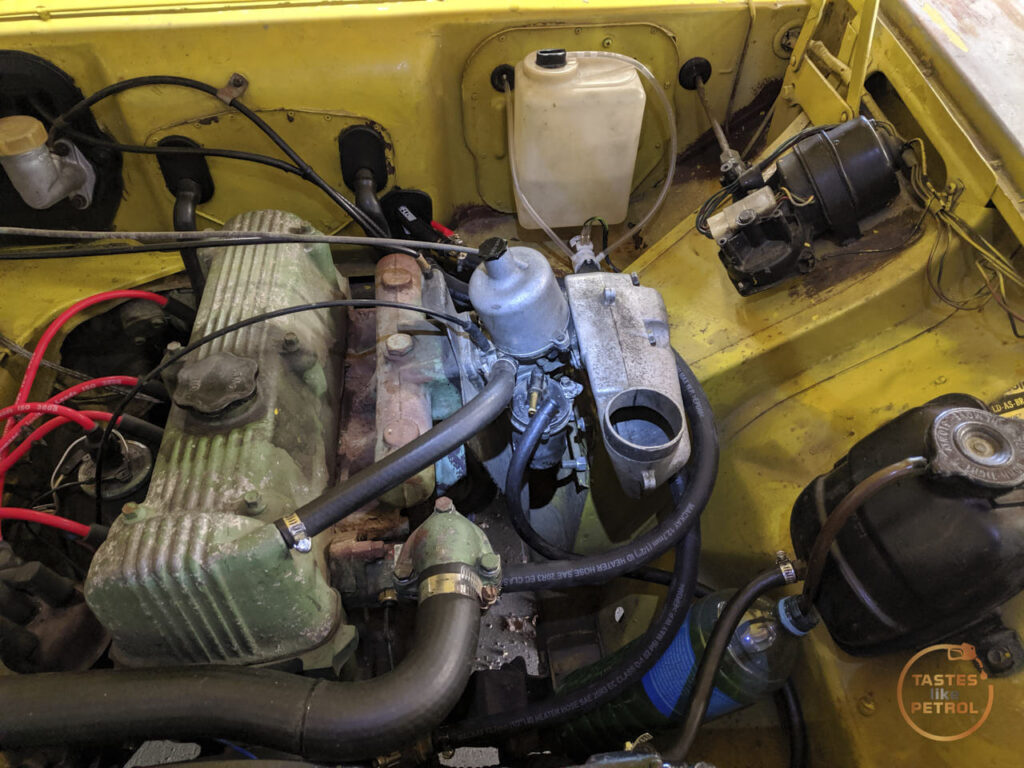
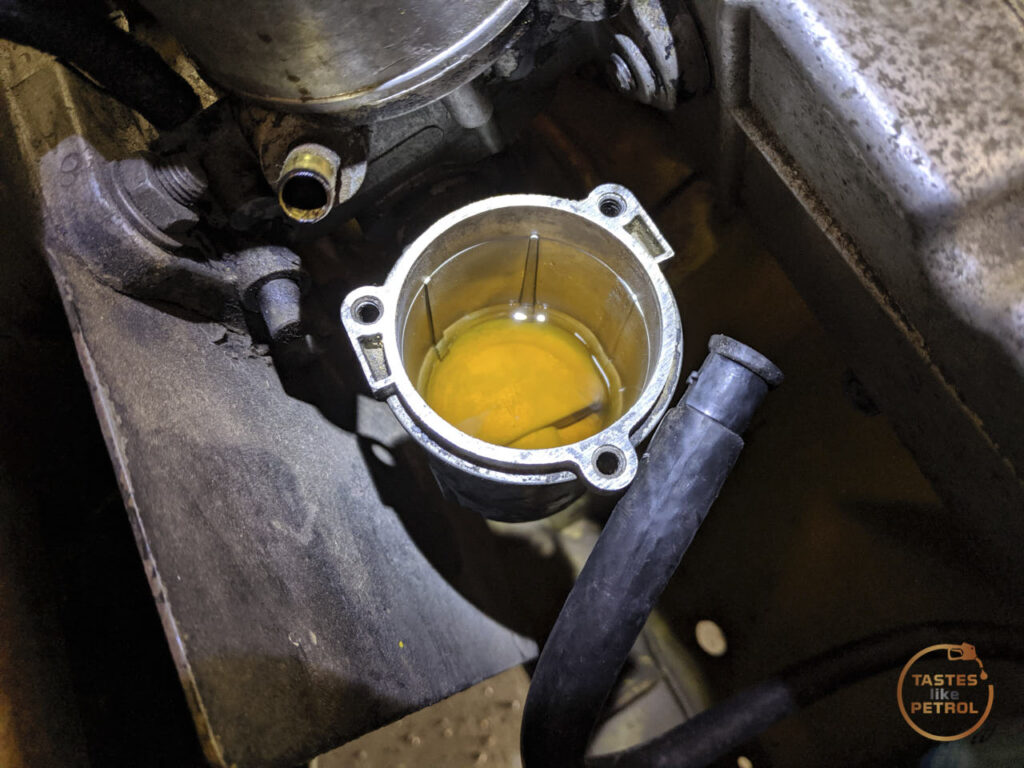


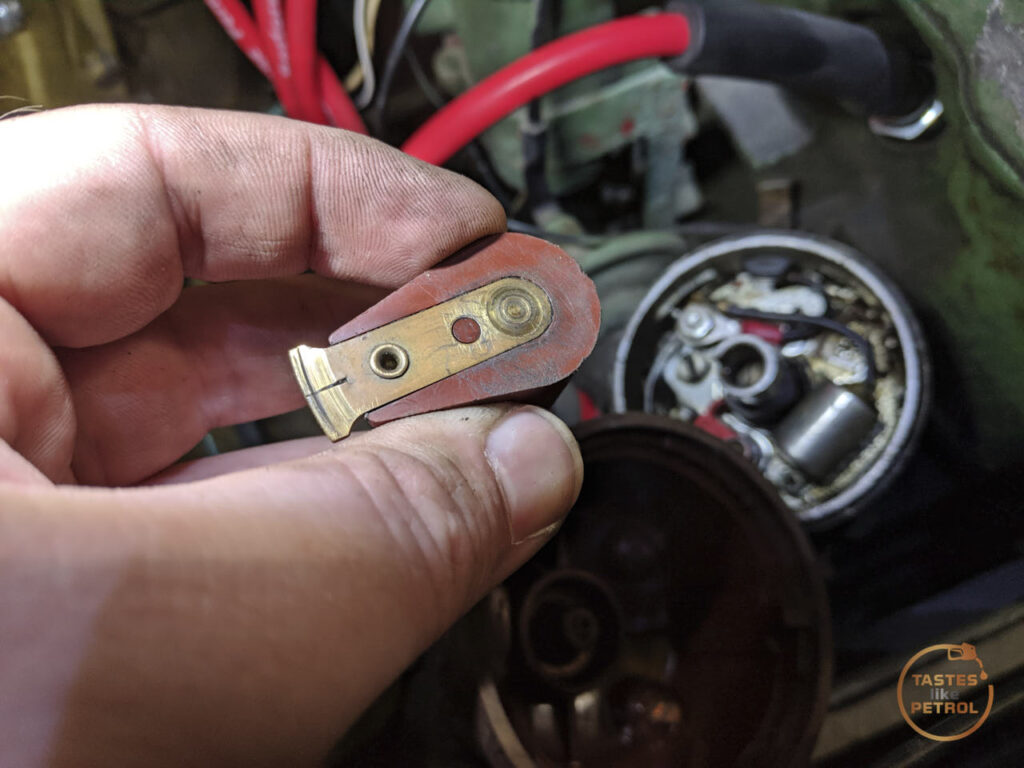
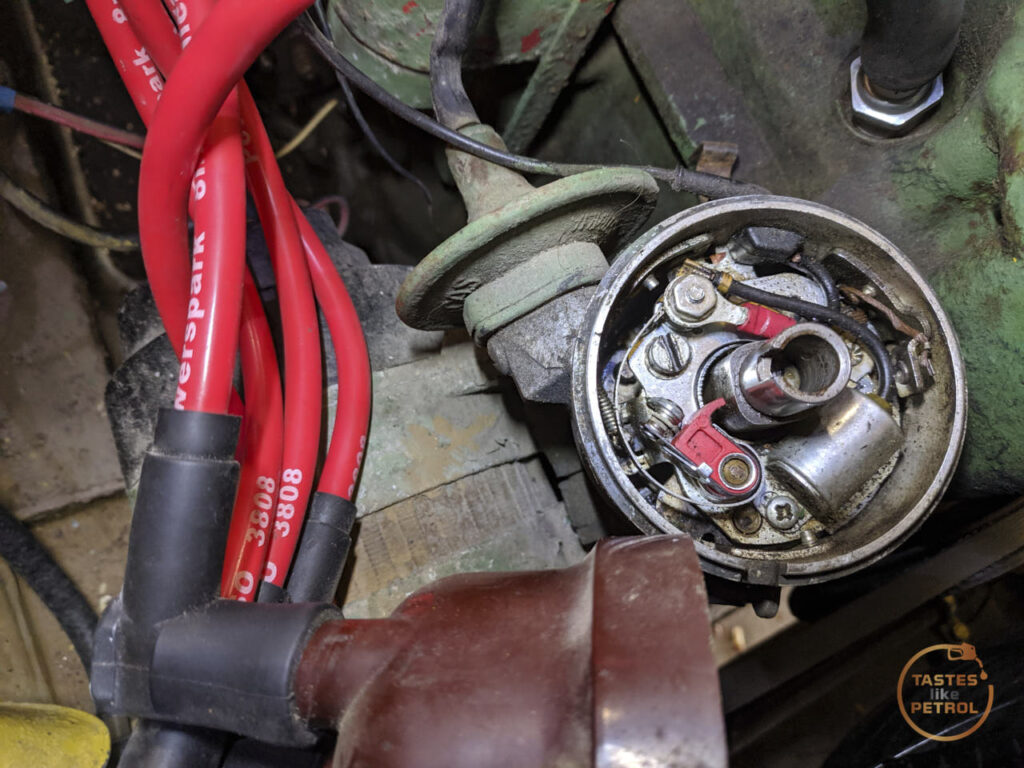


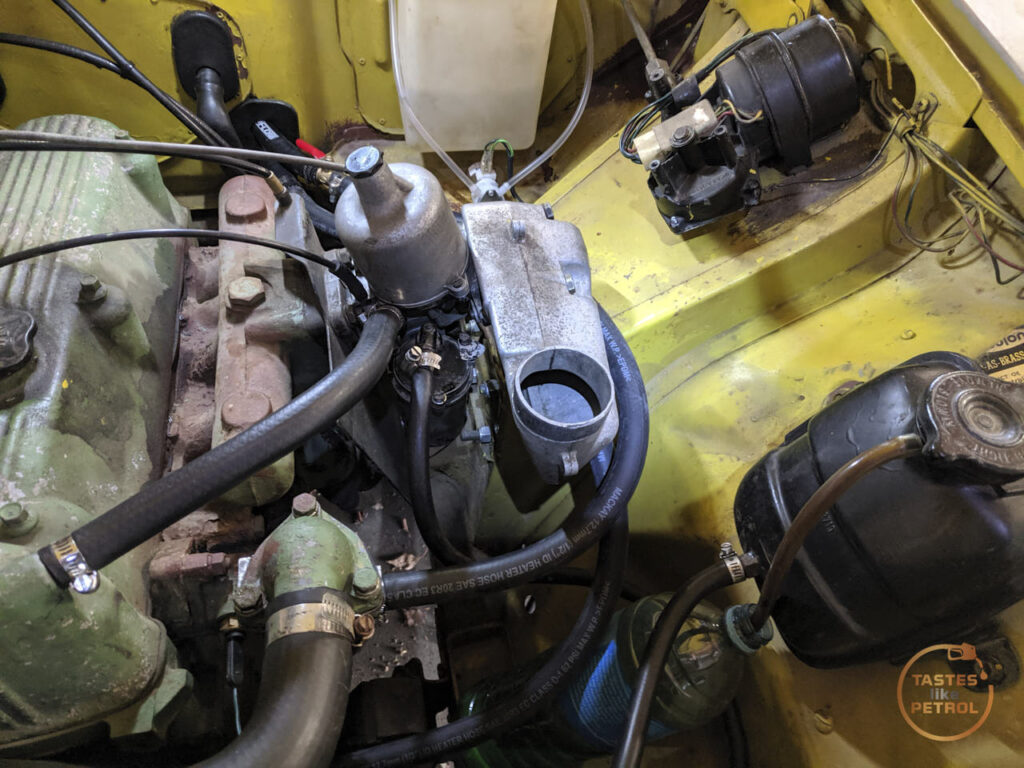

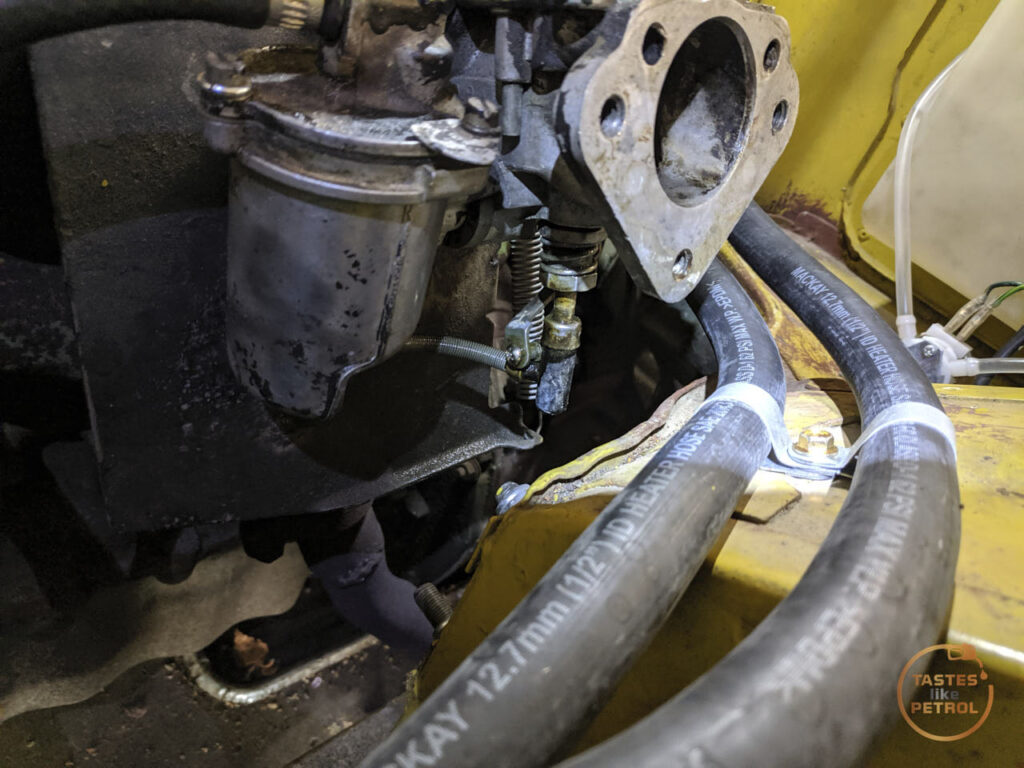




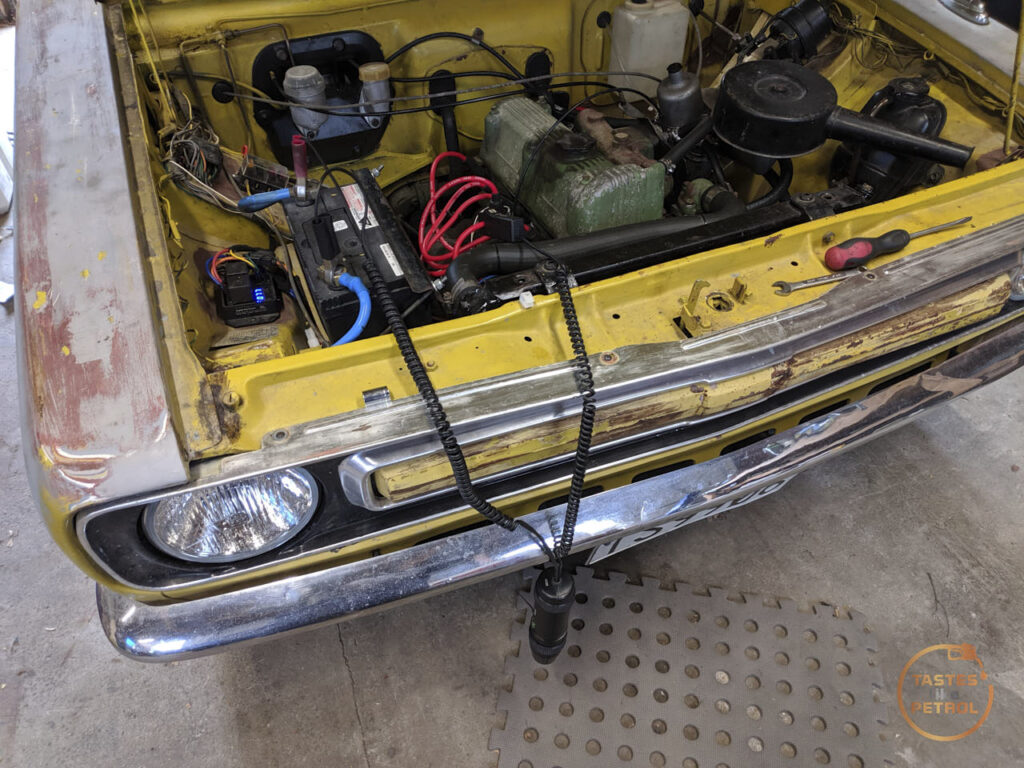



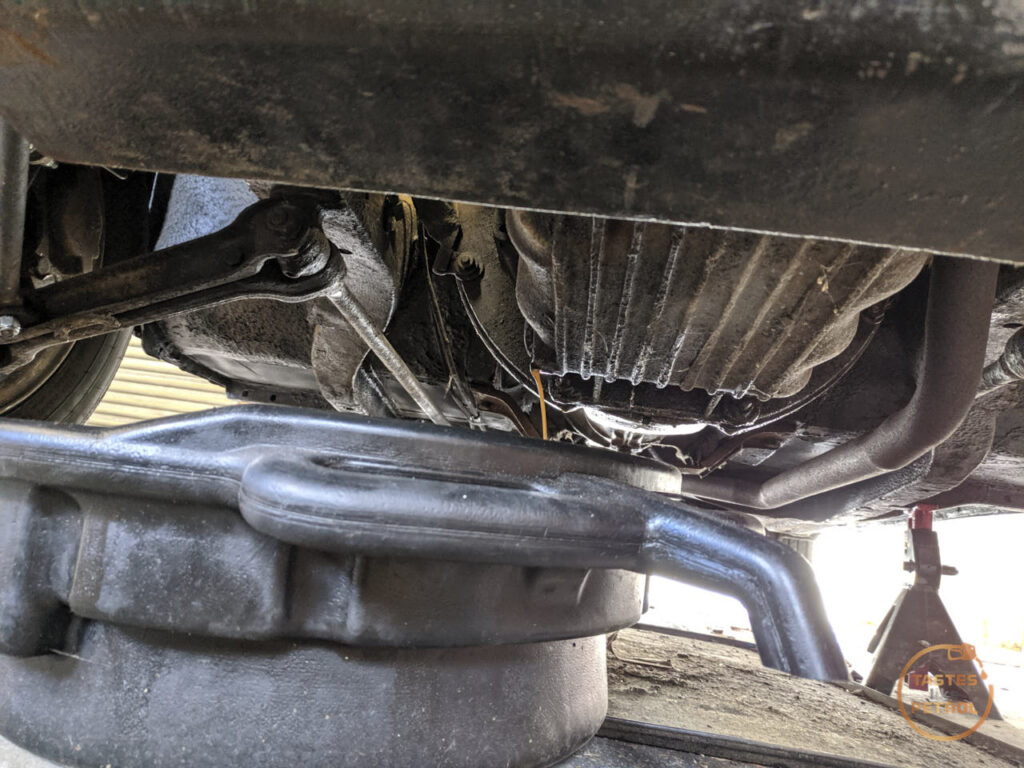

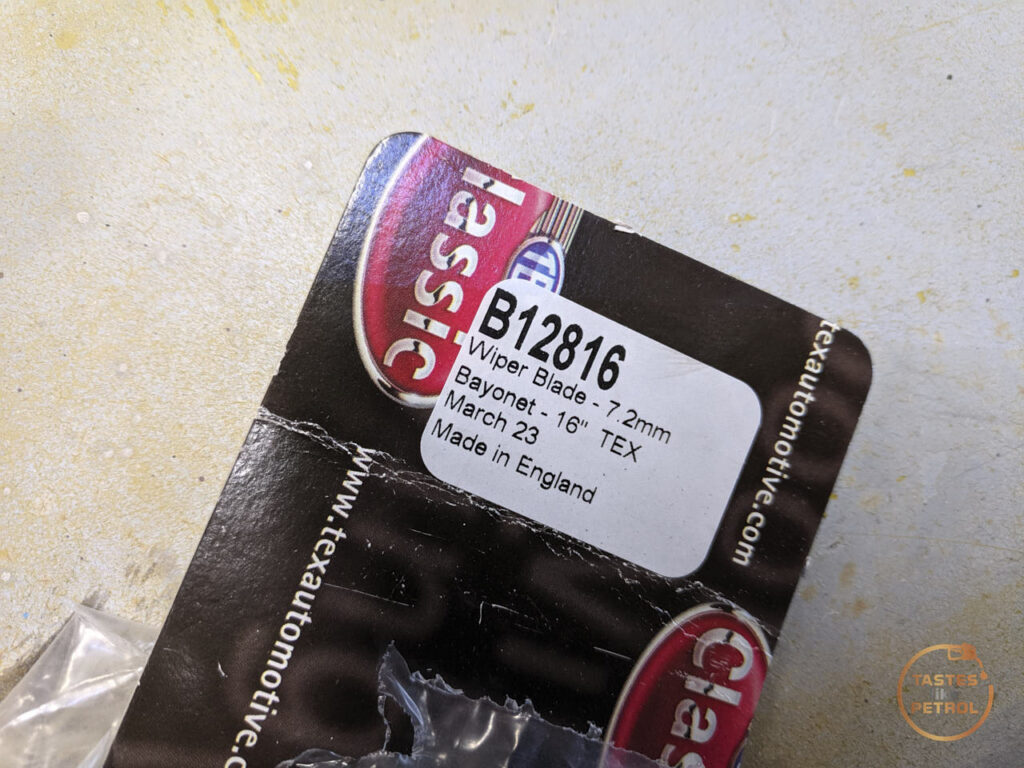
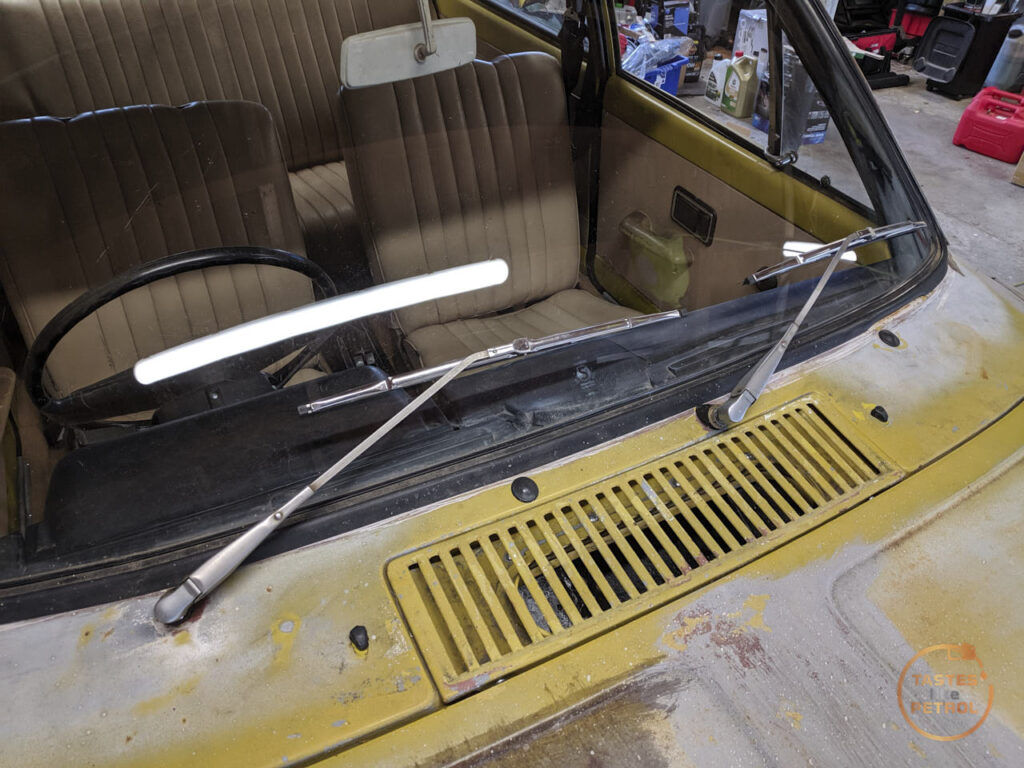



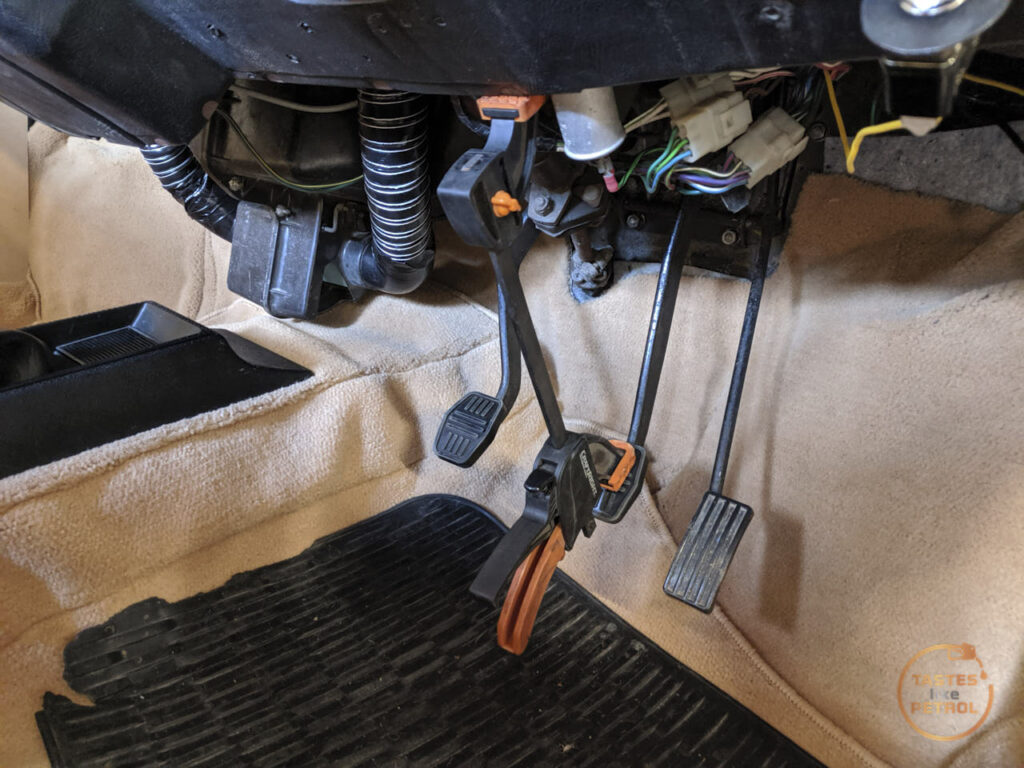



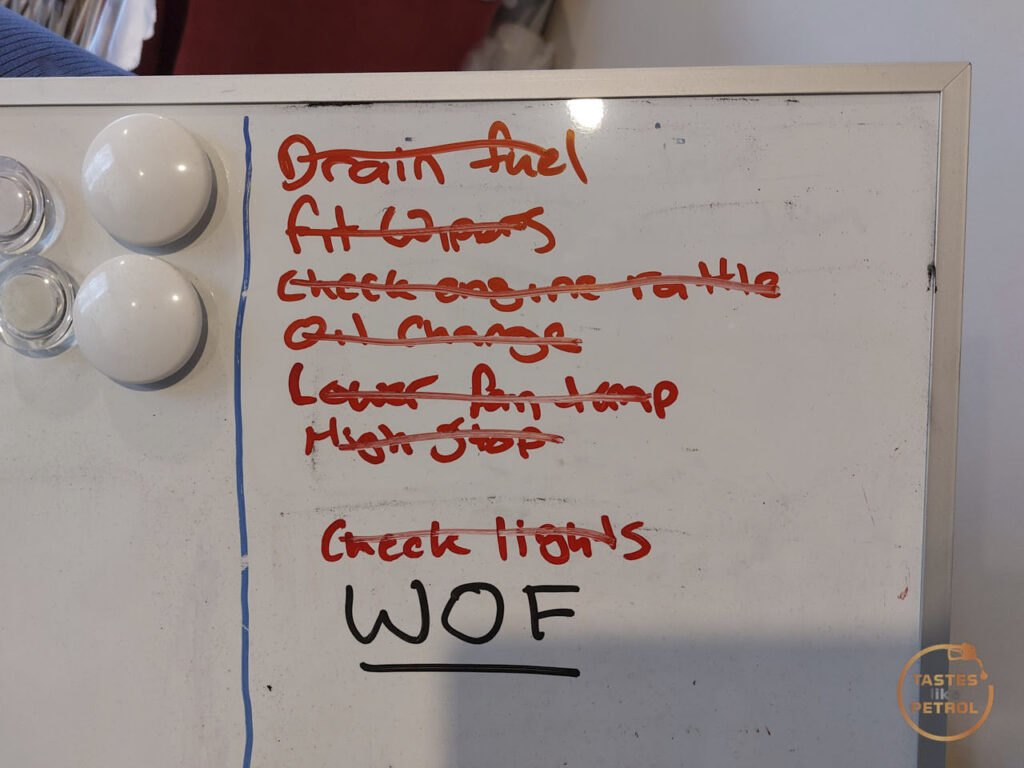



 As bought, back in 2021
As bought, back in 2021 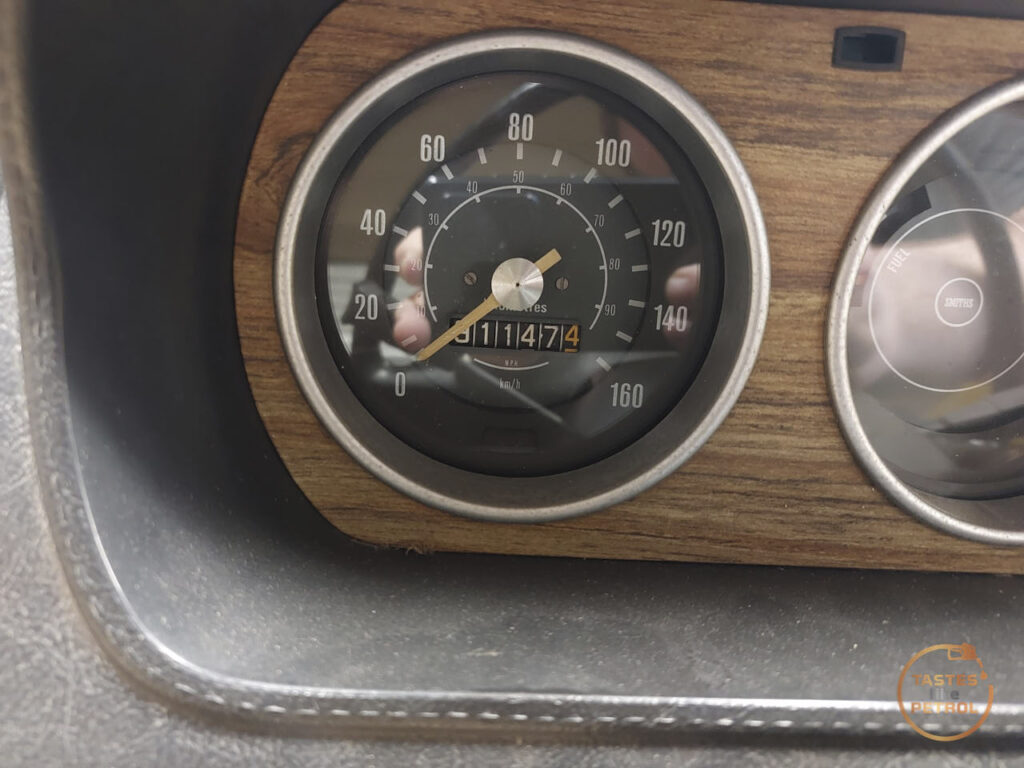 The day before the WOF, 2024
The day before the WOF, 2024
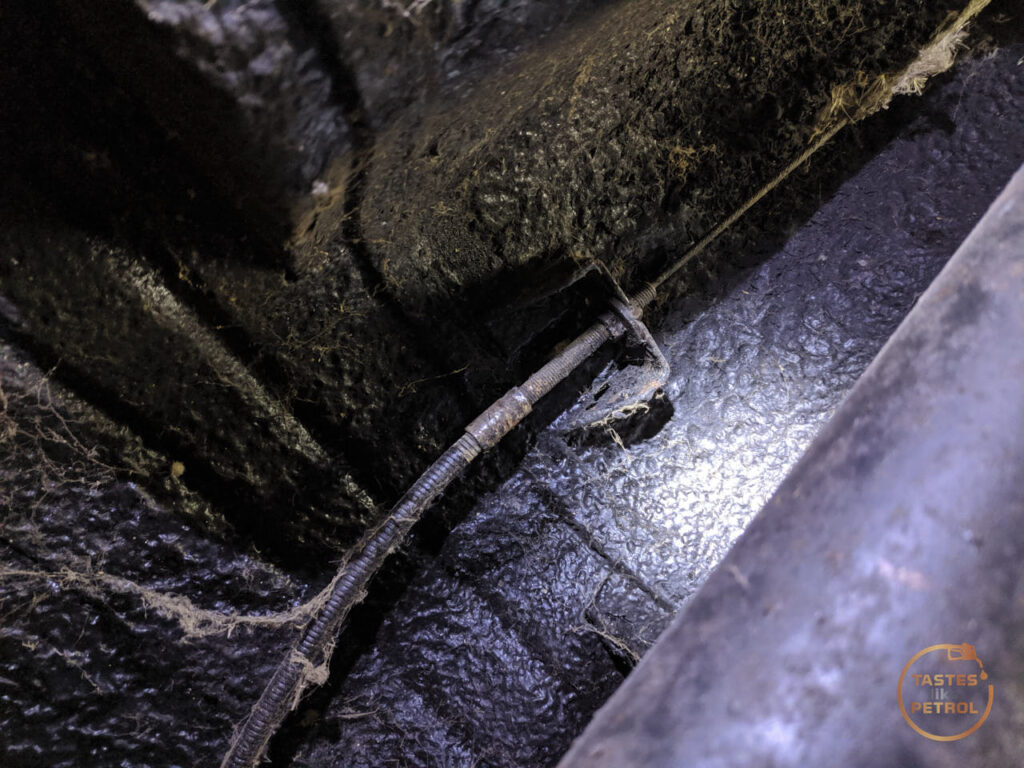
 off at the odds of that happening.
off at the odds of that happening.


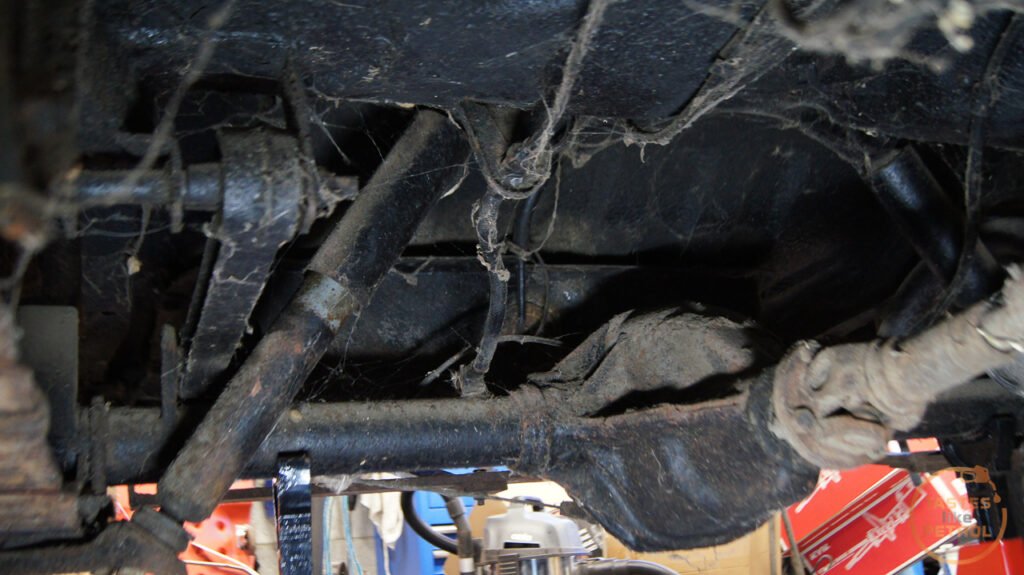
 Very old photos from when I got the car
Very old photos from when I got the car

